Home Blog Presentation Ideas About Me Slides: How to Introduce Yourself in a Presentation

About Me Slides: How to Introduce Yourself in a Presentation

From conference talks to client demos, it’s always essential to include an About Me slide in any presentation you are giving. Introducing yourself early into the presentation helps build a better rapport with the audience.
You can start with several fun facts about me slide to break the ice or go for a more formal professional bio to explain your background and what makes you qualified to talk about the topic at hand. At any rate, your goal is to get the audience on your side by revealing some of your personality.
How to Introduce Yourself in a Presentation: 4 Approaches
It’s a good practice to include self-introduction slides at the beginning of your presentation. If you are looking to answer how to introduce yourself professionally, typically somewhere after the title, opening slide , and the main agenda. However, the presentation structure will be somewhat different depending on whether you are presenting to a new audience or a group of people familiar with (e.g., your team, clients, or business partners).
Here are four about me slide ideas you can try out, plus an About me template you can use to present yourself in a presentation.

1. Mention Your Name and Affiliations
Start with the introduction basics. State your name, company, title/position, and several quick facts about who you are and what you do. Even if you present to a familiar audience, a brief recap is always welcome.
To keep things a bit more engaging, consider adding some lesser-known facts about yourself. For example:
- Your interests
- Recent accomplishments
- Testimonial/quote from a team member
- Fun nicknames you got
The above can be nice ice breakers for less formal team presentations, project updates, or catch-ups with clients.
Here are several unique About Me examples you can try out:
For a client case study presentation :
“Hi, I’m Lynda, Chief Customer Success Specialist with Acme Corp. (Also, someone you thought was a chatbot for the first few encounters)
47 NPS | 15% Churn Rate | 40% repeat purchase rate”
For a team after-action review presentation :
Mike, Project Manager at Cool Project
(aka Maximizer)
Personal Project stats:
387 Slack messages answered
56 cups of coffee consumed
Project profit gross margin: $1.2 million
2. Work On Your Elevator Pitch
One of the best ways to introduce yourself in a presentation is to share a punchy elevator pitch. This works extra well if you are presenting to a new audience.
An elevator pitch is a concise statement (1-2 sentences) that summarizes your unique strengths, skills, and abilities and explains how these can benefit your listener.
It’s nice to have one ready for your presentations and networking in general since it helps you immediately connect with new people and communicate your value.
Writing a solid elevator pitch may require several attempts and iterations. But the sooner you start — the faster you’ll arrive at the best formula!
To get your creative juices flowing, here are several elevator pitch ideas you can incorporate in an introduction slide about yourself.
For professionals:
“Certified Salesforce Administrator, data visualization specialist, and analytics for top SaaS brands. I help businesses make more sense of their data to drive better outcomes”.
For a mentor :
“Adjunct professor of creative writing at Columbia University, published author, former lifestyle editor at Esquire, the New York Times. I can teach you how to find, shape, pitch, and publish stories for web & print.”
For a student:
“Third-year Marine Biology student at Denver State Uni. Volunteer at Lake Life Protection NGO, climate change activist, looking to expand my research about water conservation”.
3. Answer Popular Questions or Assumptions
If you are a frequent presenter , chances are you get asked a lot of the same “About Me questions” after your speeches and during the networking bits. So why not address a roaster of these in your About Me slide? Select 4-5 most common questions and list them as quick FAQs on your slide deck.
4. Focus on Telling a Story
Strong introductions are personable. They are meant to offer a sneak-peak into your personality and the passion behind your work. That’s why for less formal presentations, you can (and should!) start with a short personal story.
Remember: reliability is important to “click” with your audience.
For instance, neuroscience research of political ads recently found that ads featuring real people performed better than those with genetic stock footage. Among viewers, emotional engagement and memory encoding (recall) increased dramatically when political ads showed relatable people.
The same holds true for commerce. In 2015, GE launched a viral “What’s the Matter With Owen?” video ad series to attract more young talent to the company. The clips featured a relatable protagonist, struggling to explain what his work at GE entails e.g. that the company isn’t building railroads, but actually does some very innovative pilots. Many engineers related to the promo and work applications to GE shoot up by 800% !
As the above examples show, a good relatable story can go a long way. So think about how you can make a PowerPoint presentation about yourself more representative of who you really are as a person.
How to Give a Presentation About Yourself: 4 Fool-Proof Tips
On other occasions, you may be asked to give a full-length “about me” presentation. Typically, this is the case during a second interview, onboarding , or if you are in attending a training program or workshop where everyone needs to present themselves and their work.
Obviously, you’ll need more than one good about me slide in this case. So here’s how to prepare a superb presentation about me.
What to Put in a Presentation About Yourself?
The audience will expect to learn a mix of personal and professional facts about you. Thus, it’s a good idea to include the following information:
- Your name, contact info, website , social media handles, digital portfolio .
- Short bio or some interesting snippets.
- Career timeline (if applicable).
- Main achievements (preferably quantifiable).
- Education, special training.
- Digital badging awards , accolades, and other types of recognition.
- Something more personal — an interest, hobby, aspiration.
The above mix of items will change a bit, depending on whether you are giving an interview presentation about yourself or introduce yourself post-hiring. For example, in some cases a dedicated bio slide may be useful, but other times focusing on main achievements and goals can be better.
That being said, let’s take a closer look at how to organize the above information in a memorable presentation.
P.S. Grab an about me slide template to make the design process easier!

1. Create a List of “Facts About Me”
The easiest way to answer the “tell me about yourself” question is by having an array of facts you can easily fetch from your brain.
When it comes to a full-length about me presentation , it’s best to have a longer list ready. To keep your brainstorming process productive, organize all your ideas in the following buckets:
- Key skills (soft and hard)
- Educational accolades, training
- Accomplishments and other “bragging rights”
- Personal tidbits (a.k.a. fun facts )
Once you have a list, it gets easier to build a series of slides around it.
2. Think Like Your Audience
Most likely you’d be asked to make a presentation about yourself by a recruiter. There’s a good reason why many ask this — they want to determine if you are a good “cultural fit” for their organization.
After all, 33% of people quit within the first 3 months of accepting a new job. Among these:
- 43% of employees quit because their day-to-day role was different than what they were told it would be during the hiring process.
- 32% cite company culture as a factor for leaving within the first three months.
About me presentations often serve as an extra “filter” helping both parties ensure that they are on the same page expectations- and work style-wise. Thus, when you prepare your slide deck, do some background company research. Then try to align the presentation with it by matching the company tone, communication style, and cultural values.
3. Include Testimonials and Recommendations
Use the voice of others to back up the claims you are making in your presentation. After all, trumping your own horn is what you are expected to do in such a presentation. But the voices of others can strengthen the claims you are personally making.
Depending on your role and industry, try to sprinkle some of the following testimonials:
- LinkedIn recommendations
- Quotes from personal or professional references
- Social media comments
- Data metrics of your performance
- Funny assessments from your colleagues/friends
The above not just strengthen your narrative, but also help the audience learn some extras about you and your background. Testimonial slides can be of help for this purpose.
4. Include a Case Study
One of the best ways to illustrate who you are is to show what you are best in. Remember, an about me presentation often needs to “soft sell” your qualifications, experience, and personality.
One of the best ways to do that is to showcase how you can feel in a specific need and solve issues the business is facing.
So if you have the timeframe, use some of the ending slides to deliver a quick case study. You can present:
- Short retrospective of a past successful project
- Before-after transformations you’ve achieved
- Spotlight of the main accomplishments within the previous role
- Main customer results obtained
- Specific solution delivered by you (or the team you’ve worked with)
Ending your presentation on such a high note will leave the audience positively impressed and wondering what results you could achieve for them.
To Conclude
It’s easy to feel stumped when you are asked to talk about yourself. Because there are so many things you could mention (but not necessarily should). At the same time, you don’t want to make your introduction sound like a bragging context. So always think from the position of your audience. Do the facts you choose to share benefit them in any way? If yes, place them confidently on your About Me slides!
1. Personal Self Introduction PowerPoint Template
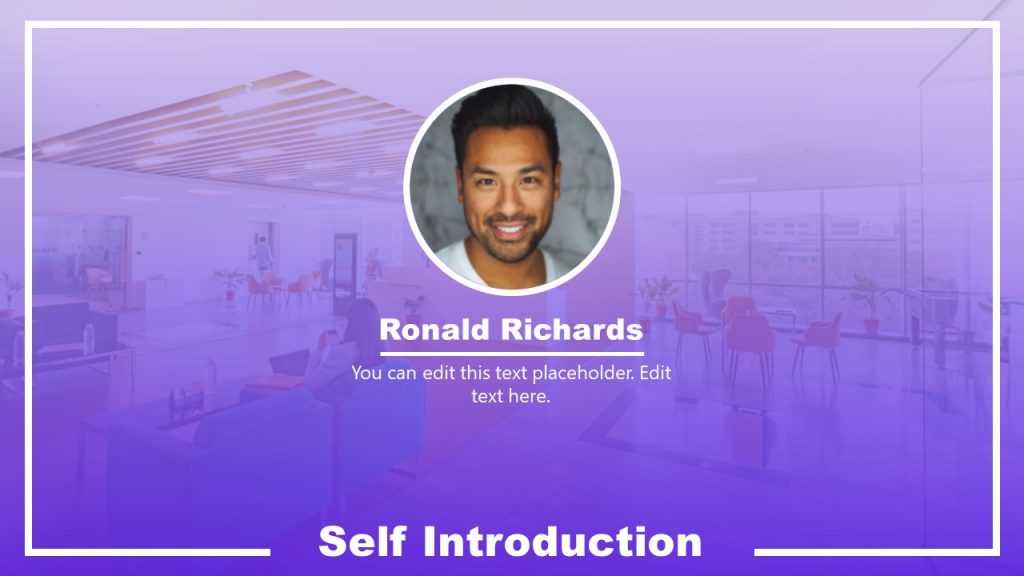
Use This Template
2. Self Introduction PowerPoint Template

3. Meet the Team PowerPoint Template Slides

4. Introduce Company Profile PowerPoint Template

5. Modern 1-Page Resume Template for PowerPoint

6. Modern Resume Presentation Template
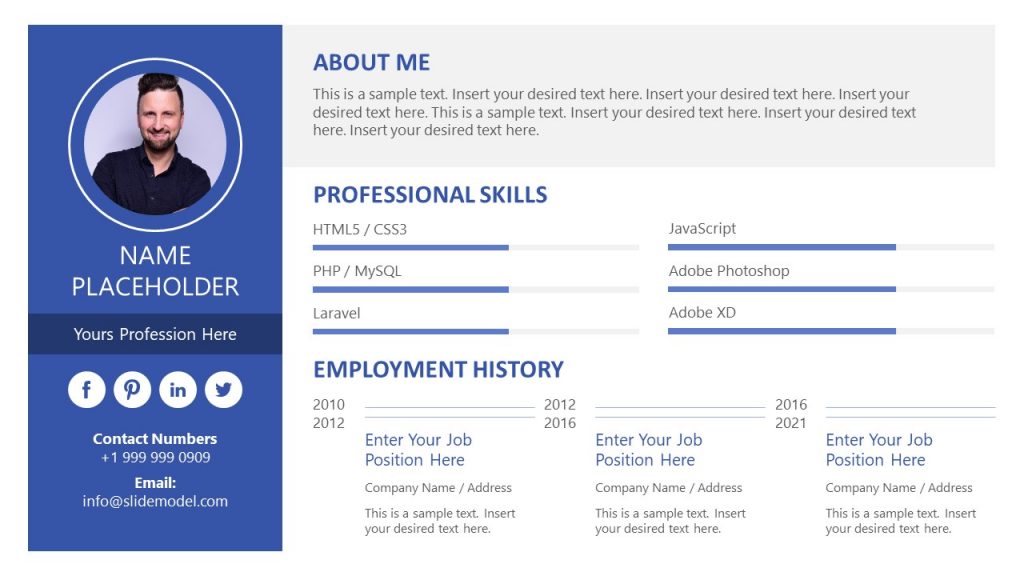
Like this article? Please share
Introduce Yourself, Introduction, Presentation Ideas Filed under Presentation Ideas
Related Articles

Filed under Presentation Ideas • February 15th, 2024
How to Create a 5 Minutes Presentation
Master the art of short-format speeches like the 5 minutes presentation with this article. Insights on content structure, audience engagement and more.
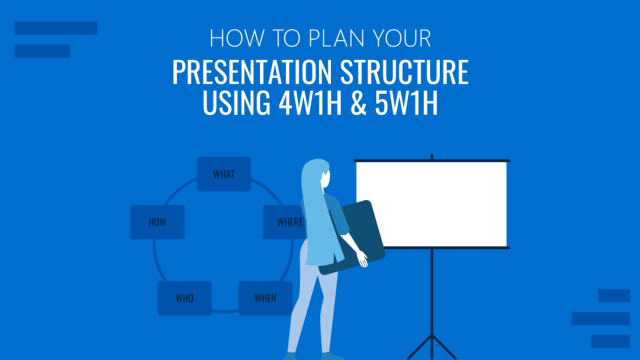
Filed under Design • January 24th, 2024
How to Plan Your Presentation Using the 4W1H & 5W1H Framework
The 4W1H and 5W1H problem-solving frameworks can benefit presenters who look for a creative outlook in presentation structure design. Learn why here.
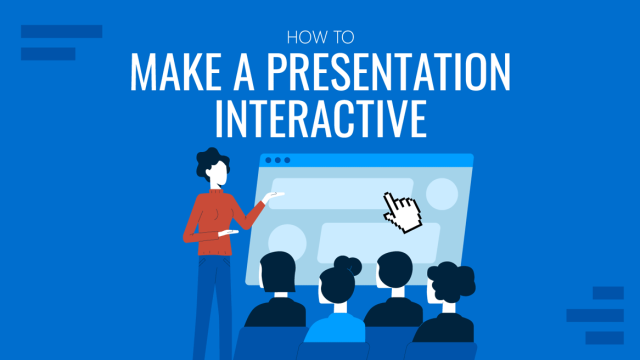
Filed under Presentation Ideas • December 13th, 2023
How To Make a Presentation Interactive
In this article, we will explore the insights behind what makes a presentation interactive. Join us to discover techniques that guarantee a presentation success.
Leave a Reply

How it works
Transform your enterprise with the scalable mindsets, skills, & behavior change that drive performance.
Explore how BetterUp connects to your core business systems.
We pair AI with the latest in human-centered coaching to drive powerful, lasting learning and behavior change.
Build leaders that accelerate team performance and engagement.
Unlock performance potential at scale with AI-powered curated growth journeys.
Build resilience, well-being and agility to drive performance across your entire enterprise.
Transform your business, starting with your sales leaders.
Unlock business impact from the top with executive coaching.
Foster a culture of inclusion and belonging.
Accelerate the performance and potential of your agencies and employees.
See how innovative organizations use BetterUp to build a thriving workforce.
Discover how BetterUp measurably impacts key business outcomes for organizations like yours.
A demo is the first step to transforming your business. Meet with us to develop a plan for attaining your goals.

- What is coaching?
Learn how 1:1 coaching works, who its for, and if it's right for you.
Accelerate your personal and professional growth with the expert guidance of a BetterUp Coach.
Types of Coaching
Navigate career transitions, accelerate your professional growth, and achieve your career goals with expert coaching.
Enhance your communication skills for better personal and professional relationships, with tailored coaching that focuses on your needs.
Find balance, resilience, and well-being in all areas of your life with holistic coaching designed to empower you.
Discover your perfect match : Take our 5-minute assessment and let us pair you with one of our top Coaches tailored just for you.

Best practices, research, and tools to fuel individual and business growth.
View on-demand BetterUp events and learn about upcoming live discussions.
The latest insights and ideas for building a high-performing workplace.
- BetterUp Briefing
The online magazine that helps you understand tomorrow's workforce trends, today.
Innovative research featured in peer-reviewed journals, press, and more.
Founded in 2022 to deepen the understanding of the intersection of well-being, purpose, and performance
We're on a mission to help everyone live with clarity, purpose, and passion.
Join us and create impactful change.
Read the buzz about BetterUp.
Meet the leadership that's passionate about empowering your workforce.

For Business
For Individuals
The self presentation theory and how to present your best self

Transform your life
Make meaningful changes and become the best version of yourself. BetterUp's professional Coaches are here to support your personal growth journey.

Jump to section
What does self presentation mean?
What are self presentation goals, individual differences and self presentation.
How can you make the most of the self presentation theory at work?
We all want others to see us as confident, competent, and likeable — even if we don’t necessarily feel that way all the time. In fact, we make dozens of decisions every day — whether consciously or unconsciously — to get people to see us as we want to be seen. But is this kind of self presentation dishonest? Shouldn’t we just be ourselves?
Success requires interacting with other people. We can’t control the other side of those interactions. But we can think about how the other person might see us and make choices about what we want to convey.
Self presentation is any behavior or action made with the intention to influence or change how other people see you. Anytime we're trying to get people to think of us a certain way, it's an act of self presentation. Generally speaking, we work to present ourselves as favorably as possible. What that means can vary depending on the situation and the other person.
Although at first glance this may seem disingenuous, we all engage in self-presentation. We want to make sure that we show up in a way that not only makes us look good, but makes us feel good about ourselves.
Early research on self presentation focused on narcissism and sociopathy, and how people might use the impression others have of them to manipulate others for their benefit. However, self presentation and manipulation are distinct. After all, managing the way others see us works for their benefit as well as ours.
Imagine, for example, a friend was complaining to you about a tough time they were having at work . You may want to show up as a compassionate person. However, it also benefits your friend — they feel heard and able to express what is bothering them when you appear to be present, attentive, and considerate of their feelings. In this case, you’d be conscious of projecting a caring image, even if your mind was elsewhere, because you value the relationship and your friend’s experience.
To some extent, every aspect of our lives depends on successful self-presentation. We want our families to feel that we are worthy of attention and love. We present ourselves as studious and responsible to our teachers. We want to seem fun and interesting at a party, and confident at networking events. Even landing a job depends on you convincing the interviewer that you are the best person for the role.
There are three main reasons why people engage in self presentation:
Tangible or social benefits:
In order to achieve the results we want, it often requires that we behave a certain way. In other words, certain behaviors are desirable in certain situations. Matching our behavior to the circumstances can help us connect to others, develop a sense of belonging , and attune to the needs and feelings of others.
Example: Michelle is a new manager . At her first leadership meeting, someone makes a joke that she doesn’t quite get. When everyone else laughs, she smiles, even though she’s not sure why.
By laughing along with the joke, Michelle is trying to fit in and appear “in the know.” Perhaps more importantly, she avoids feeling (or at least appearing) left out, humorless, or revealing that she didn’t get it — which may hurt her confidence and how she interacts with the group in the future.
To facilitate social interaction:
As mentioned, certain circumstances and roles call for certain behaviors. Imagine a defense attorney. Do you think of them a certain way? Do you have expectations for what they do — or don’t — do? If you saw them frantically searching for their car keys, would you feel confident with them defending your case?
If the answer is no, then you have a good idea of why self presentation is critical to social functioning. We’re surprised when people don’t present themselves in a way that we feel is consistent with the demands of their role. Having an understanding of what is expected of you — whether at home, work, or in relationships — may help you succeed by inspiring confidence in others.
Example: Christopher has always been called a “know-it-all.” He reads frequently and across a variety of topics, but gets nervous and tends to talk over people. When attending a networking event, he is uncharacteristically quiet. Even though he would love to speak up, he’s afraid of being seen as someone who “dominates” the conversation.
Identity Construction:
It’s not enough for us to declare who we are or what we want to be — we have to take actions consistent with that identity. In many cases, we also have to get others to buy into this image of ourselves as well. Whether it’s a personality trait or a promotion, it can be said that we’re not who we think we are, but who others see.
Example: Jordan is interested in moving to a client-facing role. However, in their last performance review, their manager commented that Jordan seemed “more comfortable working independently.”
Declaring themselves a “people person” won’t make Jordan’s manager see them any differently. In order to gain their manager’s confidence, Jordan will have to show up as someone who can comfortably engage with clients and thrive in their new role.
We may also use self presentation to reinforce a desired identity for ourselves. If we want to accomplish something, make a change, or learn a new skill , making it public is a powerful strategy. There's a reason why people who share their goals are more likely to be successful. The positive pressure can help us stay accountable to our commitments in a way that would be hard to accomplish alone.
Example: Fatima wants to run a 5K. She’s signed up for a couple before, but her perfectionist tendencies lead her to skip race day because she feels she hasn’t trained enough. However, when her friend asks her to run a 5K with her, she shows up without a second thought.
In Fatima’s case, the positive pressure — along with the desire to serve a more important value (friendship) — makes showing up easy.
Because we spend so much time with other people (and our success largely depends on what they think of us), we all curate our appearance in one way or another. However, we don’t all desire to have people see us in the same way or to achieve the same goals. Our experiences and outcomes may vary based on a variety of factors.
One important factor is our level of self-monitoring when we interact with others. Some people are particularly concerned about creating a good impression, while others are uninterested. This can vary not only in individuals, but by circumstances. A person may feel very confident at work , but nervous about making a good impression on a first date.
Another factor is self-consciousness — that is, how aware people are of themselves in a given circumstance. People that score high on scales of public self-consciousness are aware of how they come across socially. This tends to make it easier for them to align their behavior with the perception that they want others to have of them.
Finally, it's not enough to simply want other people to see you differently. In order to successfully change how other people perceive you, need to have three main skills:
1. Perception and empathy
Successful self-presentation depends on being able to correctly perceive how people are feeling , what's important to them, and which traits you need to project in order to achieve your intended outcomes.
2. Motivation
If we don’t have a compelling reason to change the perception that others have of us, we are not likely to try to change our behavior. Your desire for a particular outcome, whether it's social or material, creates a sense of urgency.
3. A matching skill set
You’ve got to be able to walk the talk. Your actions will convince others more than anything you say. In other words, you have to provide evidence that you are the person you say you are. You may run into challenges if you're trying to portray yourself as skilled in an area where you actually lack experience.
How can you make the most of the self presentation theory at work?
At its heart, self presentation requires a high-level of self awareness and empathy. In order to make sure that we're showing up as our best in every circumstance — and with each person — we have to be aware of our own motivation as well as what would make the biggest difference to the person in front of us.
Here are 6 strategies to learn to make the most of the self-presentation theory in your career:
1. Get feedback from people around you
Ask a trusted friend or mentor to share what you can improve. Asking for feedback about specific experiences, like a recent project or presentation, will make their suggestions more relevant and easier to implement.
2. Study people who have been successful in your role
Look at how they interact with other people. How do you perceive them? Have they had to cultivate particular skills or ways of interacting with others that may not have come easily to them?
3. Be yourself
Look for areas where you naturally excel and stand out. If you feel comfortable, confident, and happy, you’ll have an easier time projecting that to others. It’s much harder to present yourself as confident when you’re uncomfortable.
4. Be aware that you may mess up
As you work to master new skills and ways of interacting with others, keep asking for feedback . Talk to your manager, team, or a trusted friend about how you came across. If you sense that you’ve missed the mark, address it candidly. People will understand, and you’ll learn more quickly.
Try saying, “I hope that didn’t come across as _______. I want you to know that…”
5. Work with a coach
Coaches are skilled in interpersonal communication and committed to your success. Roleplay conversations to see how they land, and practice what you’ll say and do in upcoming encounters. Over time, a coach will also begin to know you well enough to notice patterns and suggest areas for improvement.
6. The identity is in the details
Don’t forget about the other aspects of your presentation. Take a moment to visualize yourself being the way that you want to be seen. Are there certain details that would make you feel more like that person? Getting organized, refreshing your wardrobe, rewriting your resume, and even cleaning your home office can all serve as powerful affirmations of your next-level self.
Self presentation is defined as the way we try to control how others see us, but it’s just as much about how we see ourselves. It is a skill to achieve a level of comfort with who we are and feel confident to choose how we self-present. Consciously working to make sure others get to see the very best of you is a wonderful way to develop into the person you want to be.
Allaya Cooks-Campbell
BetterUp Associate Learning Experience Designer
Impression management: Developing your self-presentation skills
How to make a presentation interactive and exciting, 6 presentation skills and how to improve them, how to give a good presentation that captivates any audience, what is self-preservation 5 skills for achieving it, how self-knowledge builds success: self-awareness in the workplace, 8 clever hooks for presentations (with tips), how to not be nervous for a presentation — 13 tips that work (really), self-management skills for a messy world, similar articles, how self-compassion strengthens resilience, what is self-efficacy definition and 7 ways to improve it, what is self-awareness and how to develop it, what i didn't know before working with a coach: the power of reflection, manage your energy, not your time: how to work smarter and faster, building resilience part 6: what is self-efficacy, why learning from failure is your key to success, stay connected with betterup, get our newsletter, event invites, plus product insights and research..
3100 E 5th Street, Suite 350 Austin, TX 78702
- Platform Overview
- Integrations
- Powered by AI
- BetterUp Lead
- BetterUp Manage™
- BetterUp Care™
- Sales Performance
- Diversity & Inclusion
- Case Studies
- Why BetterUp?
- About Coaching
- Find your Coach
- Career Coaching
- Communication Coaching
- Life Coaching
- News and Press
- Leadership Team
- Become a BetterUp Coach
- BetterUp Labs
- Center for Purpose & Performance
- Leadership Training
- Business Coaching
- Contact Support
- Contact Sales
- Privacy Policy
- Acceptable Use Policy
- Trust & Security
- Cookie Preferences

5 Memorable Ways to Introduce Yourself in a Presentation
by Janice Tomich
- Presentation Planning & Public Speaking Skills
Table of Contents
What Is The Role of Introducing Yourself In a Presentation?
Introducing yourself at the beginning of your presentation or keynote speech establishes your authority and credibility.
Introducing yourself effectively can also pique your audience’s interest and get their attention.
Keep your introduction short and sweet. Many presentations sink before they are even really underway by long-winded CVs recitals or too much context of what’s to come.
Your introduction needs only be a teaser of what you’ll be speaking. The goal is simply to help your audience understand the value you’ll bring to them—a short explainer of why it’s worth it for them to stay and listen.

PRO SPEAKING TIP: Many hosts scramble at the last minute to cobble together their guest’s introduction. I do presentation coaching , and I advise my clients to help out their hosts by providing an introduction to the host ahead of time. You’ll free them of the burden and they’ll have a professional introduction ready with no effort. Do be clear you want it delivered as written, since you are the best judge of what your audience wants and needs to know about you.
Why Is the Personal Introduction Important?
Once you have been introduced by the host or the master of ceremonies, your first job is to establish trust with your audience members. You need to introduce yourself in a way that lets the audience know you are an experienced subject matter expert and will draw in your audience’s attention.
Your self-introduction is an opportunity to warm the audience and create that initial connection, which helps create an inviting atmosphere where the audience members are more likely to be engaged.
Start Introducing Yourself Even Before the Event Begins

You can start the conversation with your audience even before the event begins. Social media provides an easy way to connect with your audience. You can even ask what questions your audience has on the topic you will be speaking about. Common questions can give your amazing insights of what your audience wants to learn.
Likewise, as people are gathering, you have a second brilliant opportunity to introduce yourself—before you even walk onto the stage. As people are entering the room, reach out and say hello—introduce yourself! Some of my strongest, longest lasting connections have come through doing this. Introducing yourself to members of your audience before the speech is unexpected and usually well received (it also helps to calm down before your presentation, it eases your presentation nerves ). Meeting and greeting is a perfect way to begin to warm the room for you and provides some teasers of what you might be speaking about.
5 Unusual Ways To Introduce Yourself in a Speech or Presentation
Personal self-introductions provide an opportunity to have your name, expertise and story be sticky and memorable . You want your audience to leave your presentation be thinking about what you said and who you are.
Let’s assume you’ve already been introduced by your host.
Here are 5 unusual ways to introduce yourself at the beginning of your speech that no one will forget:
1. Do the Unexpected. Be Bold.
Almost every public speaker starts with the presenter introducing themself, their credentials, and then an overview of what they plan to speak about.
Imagine if you introduced yourself differently. The effect is a far more engaged audience. Consider asking a question and fielding the responses. Or, turn the tables. Ask people to introduce themselves to each other or have a few attendees introduce themselves to you. Ask those attendees what they want to learn from your session, and then respond with how how you plan to speak to their needs within the speech.

Margarita Quihuis ESG Advisor, ED: Peace Innovation Institute, The Hague Peace Innovation Lab Stanford
2. Address the Elephant in the Room
Does your appearance send a signal that you are young and may lack experience? Or perhaps you have lots of age and wisdom on your side and are presenting to a young audience? In this case, self-deprecating humour can quickly dissolve the elephant that is consuming the room. I’ll bet you’ll long be remembered as the cheeky renegade who was able to connect with your audience.
3. Use a Problem, Solution, Benefit Format
Set up your presentation, by concisely speaking to your main point —the problem you will be addressing. Then, allude to the solution(s) you will provide as well as the benefits and outcomes that your audience will receive from implementing your solution(s).
Brevity is your friend when you introduce yourself in this way. It’s a powerful way to pull your audience into your talk.
4. Skip the Introduction
Jumping right into your presentation will catch your audience’s attention—after all, there’s no rule that you must introduce yourself right at the very beginning of your speech. If you take this approach, weave references to your expertise and a personal antidote or two within your presentation itself to establish your credibility and why your audience should continue listening. (Simply leaping in without context will cause confusion if you don’t provide some backfill to help your audience connect the dots as to why you can be trusted to speak on the topic at hand.)
5. Use a Thought-Provoking Image of Yourself

It’s not easy to find just the ‘right’ image to introduce yourself and begin your presentation, because whatever you choose needs to be striking and impactful. The key is to choose an image which easily aligns with what you will be presenting.
Opening with an image for your first PowerPoint presentation slide gives an opportunity to speak to why the image resonates for you. You should also introduce your experience as you speak to the relevance of the image.
Boring, status quo introductions within presentations are soon forgotten. They’re usually forgotten a few seconds or minutes after they are delivered. Getting your introductions right is a core part of improving your presentation skills.
If you want to stand out from the crowd in professional settings it’s necessary to create unexpected, memorable introductions. This warms every person in the room and engages them—your introduction speech does not need to be boring!
But sometimes the hardest part is getting started, and that’s where I come in.
If you’re feeling stuck on your introduction, I invite you to work with me one-on-one in a 1-hour presentation strategy session . I’ll get you started and focussed on your next steps to creating a brilliant presentation that will have your audience glad they attended and leave inspired.
Share this post:
Related Posts
How Much Should I Charge to Give a Keynote Speech?
Someone has just asked you how much you charge to give a keynote speech. What should you answer? It depends. I’m a public speaking coach. That gives me an insider’s view of keynote speaking costs
7 Public Speaking Books Actually Worth Your Time
Most people dislike public speaking. In fact, the stats say 73% of people fear delivering presentations or talks. If you are one of the 73%, you don’t have to be. There is an abundance of standout books
Yes, Anyone Can Become a Charismatic Speaker. Here’s how.
Is it possible to become a charismatic speaker if you weren’t born with the talent? Someone asked me that question at one of the first workshops I delivered as a public speaking coach. And it
Janice Tomich Site Map
Testimonials
Social Media
© 2023 Janice Tomich. All Rights Reserved. Privacy Policy | Terms of Use

Give the keynote. Without the nerves.

- Public Speaking Classes
- Corporate Presentation Training
- Online Public Speaking Course
- Northeast Region
- Midwest Region
- Southeast Region
- Central Region
- Western Region
- Presentation Skills
- 101 Public Speaking Tips
- Fear of Public Speaking
How to Introduce Yourself in a Presentation [with Examples]

In this post, we are going to cover the best way, a very simple three-step process that will help you introduce yourself in a presentation. A summary of the steps is below.
- Start with your name and company (or organization or school).
- Tell your audience what problem you can solve for them.
- Share some type of proof (social proof works best) that you can solve this problem.
I will break down each step into a simple-to-follow process. But first… a little background.
First, Identify What Your Audience Wants from Your Presentation

So, before you design your introduction, think about what your audience wants from your presentation. Why do they want to spend their valuable time listening to you? Are going to waste their time? Or, are you going to provide them with something valuable?
For instance, I have expertise in a number of different areas. I’m a public speaking coach, a keynote speaker, a best-selling author, a search engine optimization specialist, and a popular podcaster. However, if I delivered that sentence to any audience, the most likely reaction would be, “So what?” That sentence doesn’t answer any of the above questions. The statement is also really “me-focused” not “audience-focused.”
So, when I start to design my self-introduction, I want to focus just on the area of expertise related to my topic. I’m then going to answer the questions above about that particular topic. Once you have these answers, set them aside for a second. They will be important later.
How to Introduce Yourself in a Presentation in Class.

Instead, you probably want to add in a fun way to start a speech . For example, instead of introducing yourself in your class speech and starting in an awkward way, start with a startling statistic. Or start with a summary of your conclusion. Or, you could start the presentation with an inspirational quote.
Each of these presentation starters will help you lower your nervousness and decrease your awkwardness.
If you are delivering a speech in a speech competition or to an audience who doesn’t know you try this technique. Just introduce yourself by saying your name , the school you represent , and your topic . Make it easy. This way you get to your content more quickly and lower your nervousness.
Typically, after you get the first few sentences out of the way, your nervousness will drop dramatically. Since your name, school, and topic should be very easy to remember, this takes the pressure off you during the most nervous moments.
Obviously, follow the guidelines that your teacher or coach gives you. (The competition may have specific ways they want you to introduce yourself.)
How to Introduce Yourself in a Business Presentation — A Step-by-Step Guide.

In a professional setting, when new people walk into a meeting and don’t know what to expect, they will feel uncomfortable. The easiest way to ease some of that tension is to chat with your audience as they come into the room.
By the way, if you are looking for a template for an Elevator Speech , make sure to click this link.
Step #1: Start with your name and company name (or organization).
This one is easy. Just tell your audience your name and the organization that you are representing. If your organization is not a well-known brand name, you might add a short clarifying description. For instance, most people outside of the training industry have never heard of The Leader’s Institute ®. So, my step #1 might sound something like…
Hi, I’m Doug Staneart with The Leader’s Institute ®, an international leadership development company…
Still short and sweet, but a little more clear to someone who has never heard of my company.
Should you give your job title? Well… Maybe and sometimes. Add your title into the introduction only if your title adds to your credibility.
For example, if you are delivering a financial presentation and you are the Chief Financial Officer (CFO) of your company, you might mention that. Your title adds to your credibility. However, if the CFO is delivering a presentation about the value of joining a trade association, the CFO title adds little credibility. So, there is very little value in adding the title.
Step #2: Tell your audience what problem you can solve for them.

For instance, if my topic is how to deliver presentations, I have to determine why the audience would care. What problem will they have that I can help them with? For my audiences, the problem that I most often help people with is how to eliminate public speaking fear. Once I have the problem, I add that to my introduction by using the words, “I help people…”
Hi, I’m Doug Staneart with The Leader’s Institute ®, an international leadership development company, and I help people eliminate public speaking fear.
However, if my topic is How to Close a Higher Percentage of Sales Presentations , I’d likely want to alter my introduction a little. I might say something like…
Hi, I’m Doug Staneart with The Leader’s Institute ®, an international leadership development company, and I help people design more persuasive sales presentations.
I have expertise in both areas. However, I focus my introduction on just the expertise that is applicable to this audience. If I gave the first introduction to the second audience, they will likely respond by thinking, well, I don’t really get nervous speaking, so I guess I can tune out of this speech .
So, create a problem statement starting with, “I help people…” Make the statement apply to what your audience really wants.
Step #3: Share some type of proof (social proof works best) that you can solve this problem.
By the way, if you just do steps #1 and #2, your introduction will be better than most that you will hear. However, if you add Step #3, you will gain more respect (and attention) from your audience. Without adding some type of proof that you can solve this problem, you are just giving your opinion that you are an expert. However, if you can prove it, you are also proving that you are an expert.
This is the tricky part. For some reason, most people who get to this part feel like they haven’t accomplished great things, so they diminish the great accomplishments that they do have.
For instance, an easy way to offer proof is with a personal story of how you have solved that problem in the past.
A Few Examples of How to Introduce Yourself Before a Presentation.
For instance, one of my early clients was a young accountant. When I was working with him, he came up with the following introduction, “I’m Gary Gorman with Gorman and Associates CPA’s, and I help small businesses avoid IRS audits.” It was a great, audience-focused attention-getter. (No one wants to get audited.) However, as an accountant, it wasn’t like his company was getting a lot of five-star reviews on Yelp! So, he was kind of struggling with his social proof. So, I asked him a series of questions.
Me, “How many clients do you have?”
Gary, “Over 300.”
Me, “How many small business tax returns have you processed?”
Gary, “Well, at least a couple hundred a year for 15 years.”
Me, “So, at least 3000?” He nodded. “How many of your 300 clients have been audited since you have been representing them?”
He looked at me and said, “Well, none.”
So, we just added that piece of proof to his talk of introduction.
I’m Gary Gorman with Gorman and Associates CPA’s, and I help small businesses avoid IRS audits. In fact, in my career, I’ve helped clients complete over 3000 tax returns, and not a single one has ever been audited.
Here Is How I Adjust My Introduction Based on What I Want the Audience to Do.
For my proof, I have a number of options. Just like Gary, I have had a lot of clients who have had great successes. In addition, I have published two best-selling books about public speaking. I also have hundreds of thousands of people who listen to my podcast each week. So, I can pick my evidence based on what I want my audience to do.
For instance, if I’m speaking at a convention, and I want the audience to come by my booth to purchase my books, my introduction might sound like this.
Hi, I’m Doug Staneart with The Leader’s Institute ®, an international leadership development company, and I help people eliminate public speaking fear. One of the things that I’m most know for is being the author of two best-selling books, Fearless Presentations and Mastering Presentations.
However, if I’m leading a webinar, I may want the audience to purchase a seat in one of my classes. In that case, my introduction might sound like this.
Hi, I’m Doug Staneart with The Leader’s Institute ®, an international leadership development company, and I help people eliminate public speaking fear. For instance, for the last 20 years, I’ve taught public speaking classes to over 20,000 people, and I haven’t had a single person fail to reduce their nervousness significantly in just two days.
If my goal is to get the audience to subscribe to my podcast, my intro might sound like…
Hi, I’m Doug Staneart with The Leader’s Institute ®, an international leadership development company, and I help people eliminate public speaking fear. One of the ways that I do this is with my weekly podcast called, Fearless Presentations, which has over one million downloads, so far.
Use the Form Below to Organize How to Introduce Yourself in a Presentation.
The point is that you want to design your introduction in a way that makes people pause and think, “Really? That sounds pretty good.” You want to avoid introductions that make your audience think, “So what?”
If you have a speech coming up and need a good introduction, complete the form below. We will send you your answers via email!
Can You Replace Your Introduction with a PowerPoint Slide?
Is it okay to make your first slide (or second slide) in your presentation slides an introduction? Sure. A good public speaker will often add an introduction slide with a biography, portrait, and maybe even contact information. I sometimes do this myself.
However, I NEVER read the slide to my audience. I often just have it showing while I deliver the short introduction using the guide above. This is a great way to share more of your work experience without sounding like you are bragging.
For tips about how many powerpoint slides to use in a presentation , click here.
Remember that There Is a Big Difference Between Your Introduction in a Presentation and Your Presentation Starter.
When you introduce yourself in a presentation, you will often just use a single sentence to tell the audience who you are. You only use this intro if the audience doesn’t know who you are. Your presentation starter, though, is quite different. Your presentation starter should be a brief introduction with relevant details about what you will cover in your presentation.
For details, see Great Ways to Start a Presentation . In that post, we show ways to get the attention of the audience. We also give examples of how to use an interesting hook, personal stories, and how to use humor to start a presentation.

Podcasts , presentation skills
View More Posts By Category: Free Public Speaking Tips | leadership tips | Online Courses | Past Fearless Presentations ® Classes | Podcasts | presentation skills | Uncategorized
How to make a great presentation
Stressed about an upcoming presentation? These talks are full of helpful tips on how to get up in front of an audience and make a lasting impression.

The secret structure of great talks

The beauty of data visualization

TED's secret to great public speaking

How to speak so that people want to listen

How great leaders inspire action

Researched by Consultants from Top-Tier Management Companies

Powerpoint Templates
Icon Bundle
Kpi Dashboard
Professional
Business Plans
Swot Analysis
Gantt Chart
Business Proposal
Marketing Plan
Project Management
Business Case
Business Model
Cyber Security
Business PPT
Digital Marketing
Digital Transformation
Human Resources
Product Management
Artificial Intelligence
Company Profile
Acknowledgement PPT
PPT Presentation
Reports Brochures
One Page Pitch
Interview PPT
All Categories
Top 10 Self-Introduction Templates with Samples and Examples
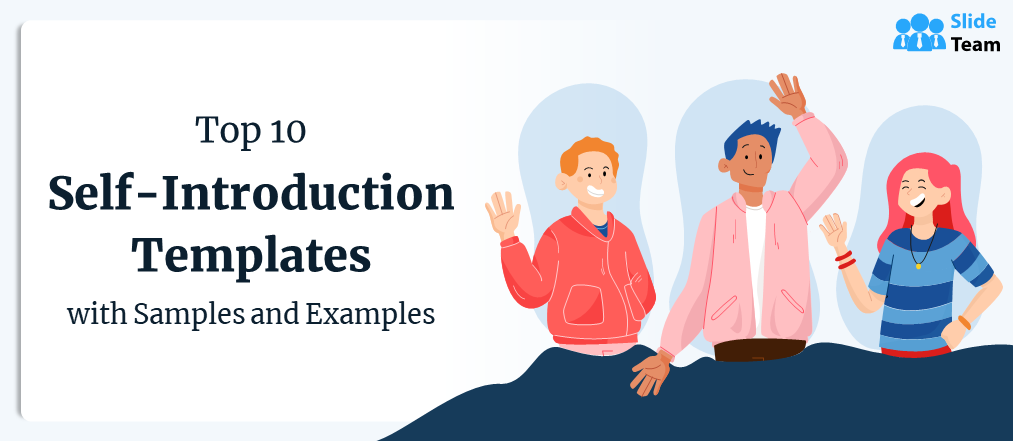
Neha Parmar
Andy completed his studies and searched for a job after that. He applied for jobs but did not get a response from anywhere, but still, he did not give up. He kept on applying for jobs. Finally, one company called him for an interview. He went and met the owner and gave a great interview and told them that he was capable of working well in the company. The owner was influenced by his way of presenting himself using self-introduction slides, and he got the job.
Andy connects with the owner and presents himself impressively. A self introduction templates helps you make connections with the right person. It is one of the best ways to introduce yourself.
Self Introduction Slide Templates for the First Impression
“ You only have one first chance to make one first impression that lasts a lifetime.”
- Nas
Top 10 Self-Introduction Templates
Template 1: 10 minutes powerpoint presentation about myself.
With the help of a PowerPoint Presentation, you can introduce yourself well. You create your presentation, and include your qualifications, weaknesses, hobbies, and work experience in it. In no time, you will be introducing yourself with confidence. If you want to show yourself in the best light, download the self introduction ppt theme now.

Download Now!
Template 2: Self Introduction For Job Interview By PowerPoint Presentation
With the help of PowerPoint Presentation Slides, we introduce ourselves. Multi-color visuals are used in these slides. A proper self-introduction is vital for making a great first impression on your audience. It includes content-ready slides such as the path to a career, SWOT analysis, personal qualifications, skills, and more. In addition, you bring tables, charts, and graphs, so the audience is impressed and sees you are perfect for the job. Grab this slide.
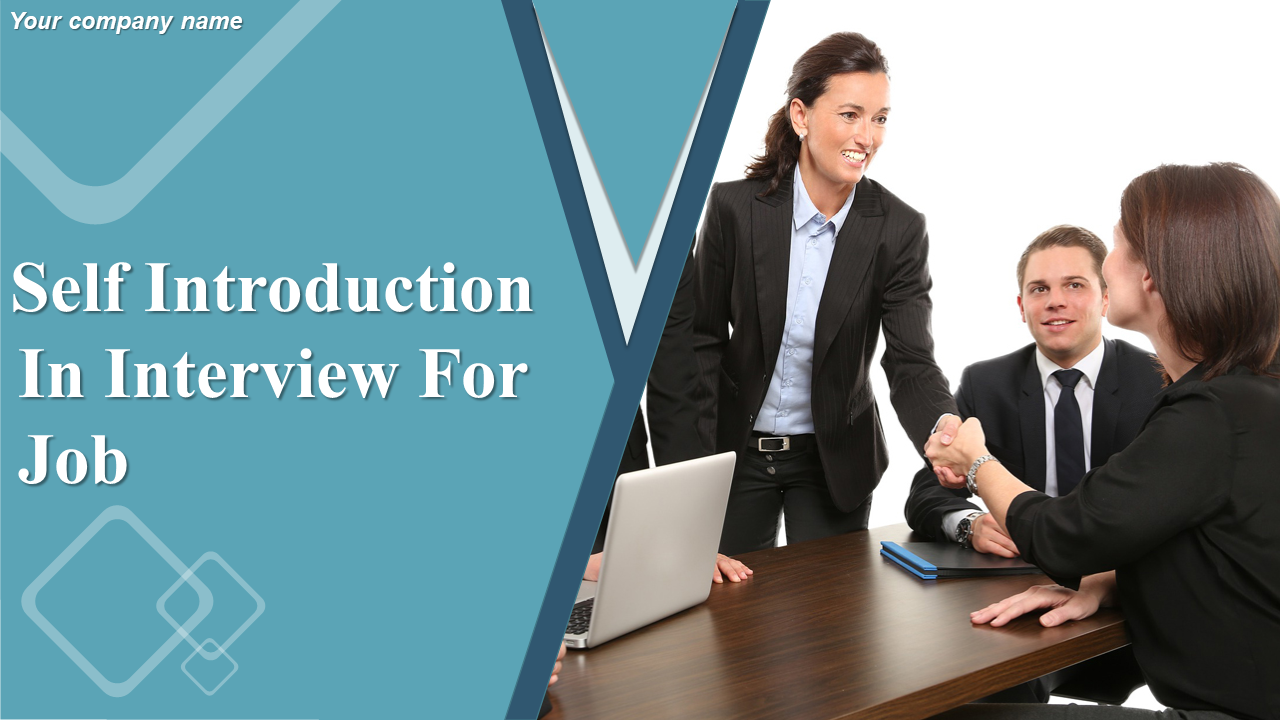
Template 3: Self-introduction In Interview For Experienced Candidate PowerPoint Presentation Slide
Use this Personal introduction PPT Slide to impress our audience. This complete deck contains slides like SWOT Analysis, personal qualifications, achievements, training, experience, case study, language skills, and hobbies.

Template 4: Self Introduction Model PowerPoint Presentation Slide
With the help of a PowerPoint Presentation, you create a profile for yourself in which you state your qualifications, work experience, skills, education, hobbies, and much more. If you want to show your aptitude for the job, download this PPT Theme now.

Template 5: Professional Self Introduction PowerPoint Presentation Slide
Professional Self Introduction PowerPoint presentation slides with suitable graphics and subject-driven content are here. All templates are completely editable for your convenience. This theme includes high-grade icons; Use this slide for short and long-term goals in the context of your strengths, weaknesses, opportunities, and treats. Get this slide now.
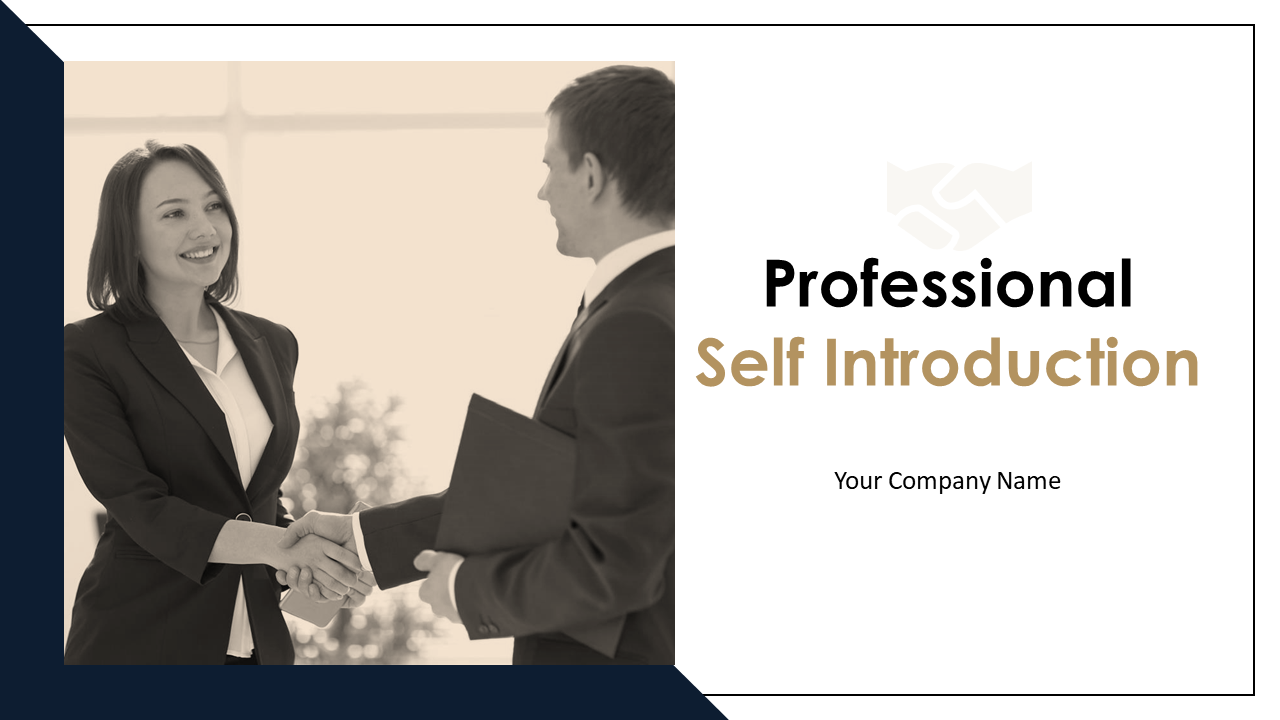
Template 6: Personal Professional Self Introduction With Icon
The PowerPoint Templates are designed to help job-seekers to understand the challenges they will face. These templates are fully editable and easy to use. Download this template to impress the interviewer.
Template 7: About Me Slide For Self Introduction In PowerPoint Presentation
Including self-introduction slides at the beginning of your presentation is a good practice. You can use the PPT Design to describe your profile, educational background, work experience, awards, achievements, and more. This PPT slide allows you to create a presentation that will help you tell your story clearly and concisely.
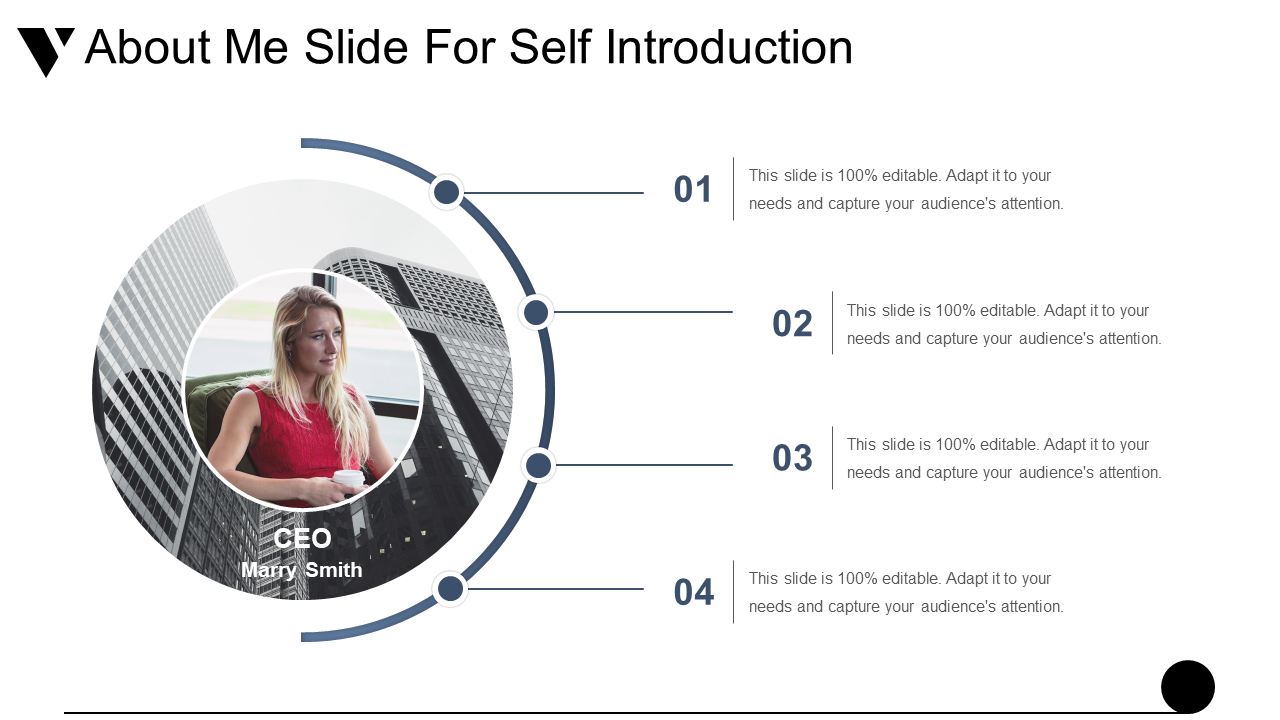
Template 8: Self Introduction Slide About Me PowerPoint Guide
Your introduction slide will help capture the audience’s attention. This PPT Template is used to illustrate skills, hobbies, work experience, and career choices in a clear and organized manner. Your audience will connect with you throughout the speech or presentation. A presentation like this includes your professional and personal information. Making the presentation takes time and effort. Download this self-introduction slide to create a presentation faster.
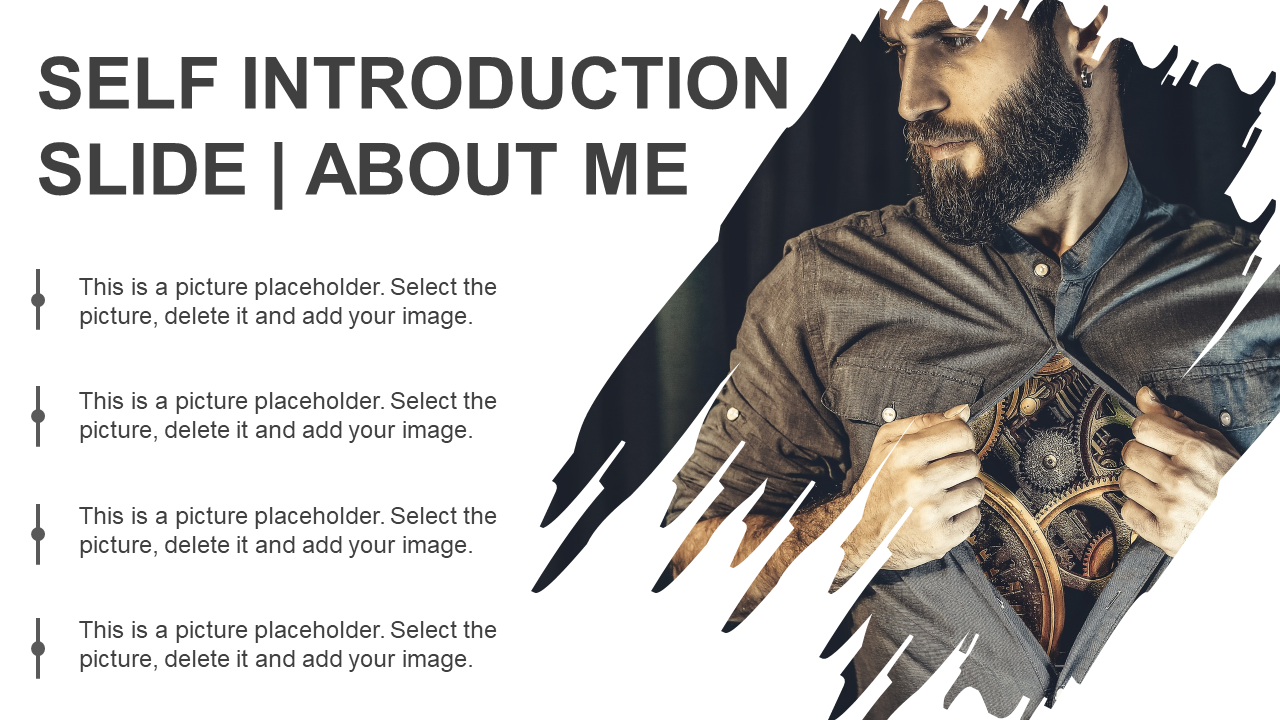
Template 9: Self Introduction of Digital Marketing Professional
Presenting our well-structured icons slide for digital marketing. Employ strategic thinking by using this complete deck and present yourself with a self-introduction format for digital marketing. Persuade your audience using this icon illustrating digital marketing PPT Theme. This slide has stages that include interest, education, and experience. It is entirely editable and is available for immediate download.
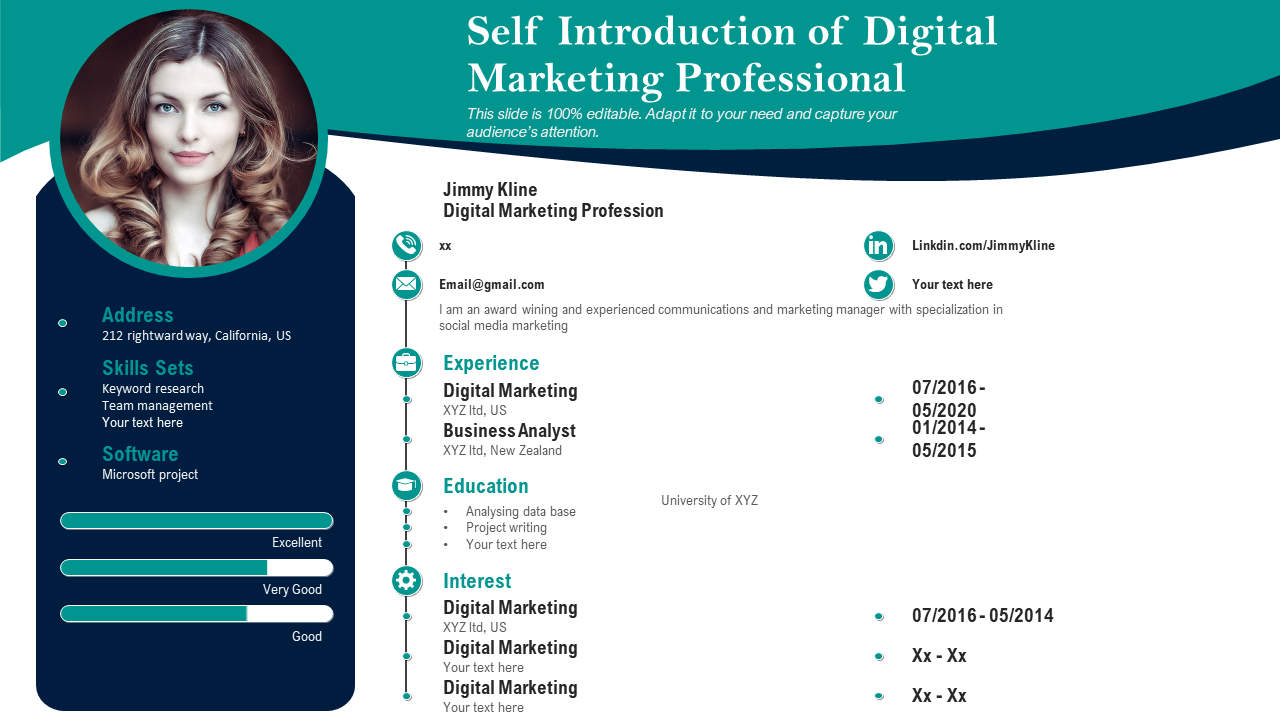
Template 10: Self Introduction CV For Job Search
A creative resume is a great way to stand out from other applicants. Catch the attention of potential employers. You can use these PowerPoint Slides to present your CV or resume to a potential employer. Each template utilizes creative slide designs and innovative visual elements to ensure that it is unique and engages the audience. Mention your skills to crack every interview by downloading ready-to-use samples.
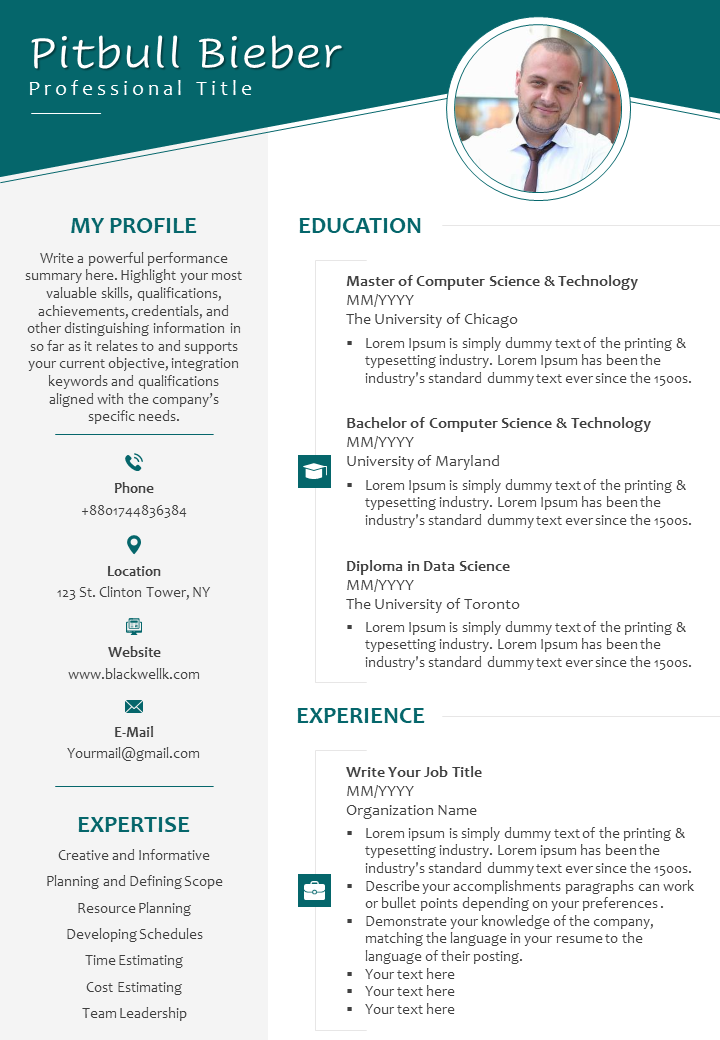
You should always feel like a million dollars when introducing yourself. Your personal or self introduction is the first way to get any opportunity. No one is perfect but by doing it again and again the perfection will come to your interviews.
FAQs on Self Introduction Templates
How can i introduce myself.
Introducing oneself is the most common question asked in an interview. When an interviewer asks about yourself, they seek information about how your qualities and characteristics that align with the skills they need. That you are passionate about your work and you are ambitious and driven.
How can I introduce myself in an interview?
The first impression happens quite fast . You introduce yourself to an audience or the owner through a PowerPoint presentation. The audience likes something that shocks and shakes them hard enough to get their attention .Try to make them so intrigued that the desire makes them want to know who you are. Show the audience what makes you unique. Connect with the audience . This is difficult, but we crack it with confidence. T Body language is a vital part of communication. For example:-
“I am John Smith. I will be here at noon for a job interview for a graphic designer. I have over five years of experience specializing in creating beautiful, unique website experiences that makes the users' time with a brand more enjoyable. I am looking forward to growing my management skills and develop and inspire a team.”
Always end the interview on a positive note.
“ It was a pleasure meeting with you. I appreciate the opportunity. .”

How will you describe yourself?
In any interview, you must make the interviewer think, “Wow! This person would be perfect for position !” The first thing to describe yourself as is a self-motivated person. You are comfortable taking the initiative and doing things independently. You will explain your experiences and qualifications. For example:
Suppose you have an English literature degree and want to work as a writer for a tech business. Be professional when you speak.
- Communicate well
- Be knowledgeable in your field of expertise
- Be inquisitive
- Be a leader , not a boss
- Ask for help when you need
- Don’t be afraid of failure
Related posts:
- Top 10 Templates to Design an Introduction Slide About Yourself (Samples and Examples Included)
- Top 10 Personal Introduction Slide Templates to Make Yourself Unforgettable
- Top 10 Autobiography Templates to Portray Your Learnings and Achievements [Free PDF Attached]
- Top 7 Introduction Templates with Samples and Examples
Liked this blog? Please recommend us

Top 10 Employee Introduction Templates to Create a Solid Onboarding Program
![creative self presentation A Complete Guide on Employee Introduction With Samples and Examples [Free PDF Attached]](https://www.slideteam.net/wp/wp-content/uploads/2022/08/1013x441no-button-9-1013x441.jpg)
A Complete Guide on Employee Introduction With Samples and Examples [Free PDF Attached]
This form is protected by reCAPTCHA - the Google Privacy Policy and Terms of Service apply.

Digital revolution powerpoint presentation slides

Sales funnel results presentation layouts
3d men joinning circular jigsaw puzzles ppt graphics icons

Business Strategic Planning Template For Organizations Powerpoint Presentation Slides

Future plan powerpoint template slide

Project Management Team Powerpoint Presentation Slides

Brand marketing powerpoint presentation slides

Launching a new service powerpoint presentation with slides go to market

Agenda powerpoint slide show

Four key metrics donut chart with percentage

Engineering and technology ppt inspiration example introduction continuous process improvement

Meet our team representing in circular format


Effective Self-Introductions (Inspiring Examples and Scripts)
By Status.net Editorial Team on September 22, 2023 — 21 minutes to read
- Structure of a Good Self-introduction Part 1
- Examples of Self Introductions in a Job Interview Part 2
- Examples of Self Introductions in a Meeting Part 3
- Examples of Casual Self-Introductions in Group Settings Part 4
- Examples of Self-Introductions on the First Day of Work Part 5
- Examples of Good Self Introductions in a Social Setting Part 6
- Examples of Good Self Introductions on Social Media Part 7
- Self-Introductions in a Public Speaking Scenario Part 8
- Name-Role-Achievements Method Template and Examples Part 9
- Past-Present-Future Method Template and Examples Part 10
- Job Application Self-Introduction Email Example Part 11
- Networking Event Self-Introduction Email Example Part 12
- Conference Self-Introduction Email Example Part 13
- Freelance Work Self-Introduction Email Example Part 14
- New Job or Position Self-Introduction Email Example Part 15
Whether you’re navigating a job interview, networking event, or simply meeting new people, the way you introduce yourself sets the tone for the entire interaction. In this comprehensive guide, we’ll equip you with the essential tools and techniques to confidently and effectively introduce yourself in any situation, leaving a lasting and positive impression.
Part 1 Structure of a Good Self-introduction
- 1. Greeting and introduction: Start by greeting the person you’re speaking to and introducing yourself. For example, “Hi, my name is Jane. Nice to meet you!”
- 2. Brief personal background: Give a brief overview of your personal background, such as where you’re from or what you do. For example, “I’m originally from California, but I moved to New York a few years ago. I work in marketing for a tech company.” Related: 10 Smart Answers: “Tell Me About Yourself”
- 3. Professional experience: Highlight your relevant professional experience, including your current or previous job titles and any notable achievements. For example, “I’ve been working in marketing for about 5 years now, and I’m currently a Senior Marketing Manager at my company. Last year, I led a successful campaign that resulted in a 20% increase in sales.” Related: How to Describe Yourself (Best Examples for Job Interviews)
- 4. Skills and strengths: Mention any skills or strengths that are relevant to the conversation or the situation you’re in. For example, “I’m really passionate about data analysis and using insights to inform marketing strategy. I’m also a strong communicator and enjoy collaborating with cross-functional teams.” Related: 195 Positive Words to Describe Yourself [with Examples] 35 Smart Answers to “What Are Your Strengths?” What Are Your Strengths And Weaknesses? (Answers & Strategies)
- 5. Personal interests: Wrap up your self-introduction by mentioning a few personal interests or hobbies, which can help to humanize you and make you more relatable. For example, “In my free time, I love hiking and exploring new trails. I’m also a big fan of trying out new restaurants and cooking at home.”
- Related: Core Values List: 150+ Awesome Examples of Personal Values Best Examples of “Fun Facts About Me” What Are Your Values? How to Discover Your Values
Part 2 Examples of Good Self Introductions in a Job Interview
When introducing yourself in an interview, you should be confident, clear, and knowledgeable. Maintain eye contact, speak with a steady tone, and be concise. Prepare your introduction beforehand to avoid stumbling or getting too wordy. Try to cover these aspects:
- Current or most recent position/job
- A relevant accomplishment or strength
- Why you are excited about the company or role
Templates and Scripts
“Hello, my name is [Your Name], and I recently worked as a [Your Most Recent Position] at [Company/Organization]. I successfully managed a team of [Number] members, achieving a [Relevant Accomplishment or Growth]. I’m excited about the opportunity at [Interviewer’s Company] because [Reason Why You’re Interested].”
“Hi, I’m [Your Name], a [Current Job Title or Major Accomplishment]. I’m passionate about [Relevant Industry or Skillset] and have a proven track record of [Specific Result or Achievement]. I believe my skills and experience make me well-suited for this role at [Company], and I’m excited to explore how I can contribute to [Company Goal or Project].”
“Hi, my name is Jane Doe, and I’m the Assistant Marketing Manager at ABC Corp. I recently implemented a successful social media campaign, which increased engagement by 30%. I’m thrilled about the possibility of working with XYZ Inc. because of your innovative marketing strategies.”
“Hello, I’m John Smith, a financial analyst with five years of experience in the banking industry. I’ve consistently exceeded sales targets and helped my team win an award for excellent customer service. I’m excited to join DEF Ltd. because of your focus on sustainable and responsible investing.”
Remember to tailor your introduction to the specific interview situation and always show enthusiasm for the position and company. This will show the interviewer that you are the right fit.
Related: How to Describe Yourself (Best Examples for Job Interviews)
Part 3 Examples of Good Self Introductions in a Meeting
General tips.
When introducing yourself in a meeting, consider these tips:
- Start with a greeting: Begin with a simple “hello” or “good morning.”
- State your name clearly: Don’t assume everyone knows you already.
- Mention your role in the company: Help others understand your position.
- Share relevant experience or accomplishments: Give context to your expertise.
- Be brief: Save detailed explanations for later conversations.
- Show enthusiasm: Display interest in the meeting and its objectives.
- Welcome others: Encourage a sense of connection and camaraderie.
Here are some templates and scripts to use when introducing yourself in a meeting:
- Basic introduction : Hi, I’m [Name], and I work as a [Your Role] in the [Department]. It’s great to meet you all.
- Involvement-focused : Good morning, everyone. I’m [Name], [Your Role]. I handle [Responsibility] in our team, and I’m looking forward to working with you on [Project].
- Experience-based : Hello! My name is [Name] and I’m the [Your Role] here. I’ve [Number of Years] of experience in [Skills or Industry], so I hope to contribute to our discussions during the meeting.
Here are some examples of self-introductions in different scenarios:
- New team member : Hi, I’m [Name]. I just joined the [Department] team as the new [Your Role]. I have a background in [Relevant Experience] and am excited to start working with you on our projects!
- External consultant : Hello everyone, my name is [Name], and I’m here in my capacity as a [Your Role] with [Your Company]. I specialize in [Skill or Industry], and I’m looking forward to partnering with your team to achieve our goals.
- Guest speaker : Good morning, I’m [Name], a [Your Position] at [Organization]. I have expertise in [Subject], and I’m honored to be here today to share my insights with you.
Related: 10 Smart Answers: “Tell Me About Yourself”
Part 4 Examples of Casual Self-Introductions in Group Settings
Template 1:.
“Hi, I’m [your name], and I’m a [profession or role]. I love [personal hobby or interest].”
“Hi, I’m Emily, and I’m a pediatric nurse. I love gardening and spending my weekends tending to my colorful flower beds.”
“Hello, I’m Mark, and I work as a data analyst. I love reading science fiction novels and discussing the intricacies of the stories with fellow book enthusiasts.”
“Hey there, I’m Jessica, and I’m a chef. I have a passion for traveling and trying new cuisines from around the world, which complements my profession perfectly.”
Template 2:
“Hey everyone, my name is [your name]. I work as a [profession or role], and when I’m not doing that, I enjoy [activity].”
“Hey everyone, my name is Alex. I work as a marketing manager, and when I’m not doing that, I enjoy hiking in the wilderness and capturing the beauty of nature with my camera.”
“Hello, I’m Michael. I work as a software developer, and when I’m not coding, I enjoy playing chess competitively and participating in local tournaments.”
“Hi there, I’m Sarah. I work as a veterinarian, and when I’m not taking care of animals, I enjoy painting landscapes and creating art inspired by my love for wildlife.”
“Hi there! I’m [your name]. I’m currently working as a [profession or role], and I have a passion for [hobby or interest].”
“Hi there! I’m Rachel. I’m currently working as a social worker, and I have a passion for advocating for mental health awareness and supporting individuals on their journeys to recovery.”
“Hello, I’m David. I’m currently working as a financial analyst, and I have a passion for volunteering at local animal shelters and helping rescue animals find their forever homes.”
“Hey, I’m Lisa. I’m currently working as a marine biologist, and I have a passion for scuba diving and exploring the vibrant underwater ecosystems that our oceans hold.”
Related: 195 Positive Words to Describe Yourself [with Examples]
Part 5 Examples of Good Self-Introductions on the First Day of Work
On your first day of work, it’s crucial to make a good impression with a well-crafted self-introduction. Keep it brief and concise, focusing on your name, role, and background. Make sure to smile, maintain eye contact, and exude confidence. It’s fine to share a little about your personal life, but avoid oversharing.
Here are some templates and scripts to help guide your self-introduction:
- Simple Introduction : “Hi, my name is [Your name], and I’m the new [Your position] here. I recently graduated from [Your university or institution] and am excited to join the team. I’m looking forward to working with you all.”
- Professional Background : “Hello everyone, I’m [Your name]. I’ve joined as the new [Your position]. With my background in [Your skills or experience], I’m eager to contribute to our projects and learn from all of you. Don’t hesitate to reach out if you have any questions.”
- Personal Touch : “Hey there! I’m [Your name], and I’ve recently joined as the new [Your position]. On the personal side, I enjoy [Your hobbies] during my free time. I’m looking forward to getting to know all of you and working together.”
Feel free to tweak these scripts as needed to fit your personality and work environment.
Here are some specific examples of self-introductions on the first day of work:
- Marketing Manager : “Hi, my name is Alex, and I’m excited to be the new Marketing Manager here. I’ve been in the marketing industry for five years and have worked on various campaigns. Outside of work, I love exploring new hiking trails and photography. I can’t wait to collaborate with you all.”
- Software Engineer : “Hello, I’m Priya, your new Software Engineer. I graduated from XYZ University with a degree in computer science and have experience in Python, Java, and web development. In my free time, I enjoy playing the guitar and attending live concerts. I’m eager to contribute to our team’s success and learn from all of you.”
Related: Core Values List: 150+ Awesome Examples of Personal Values
Part 6 Examples of Good Self Introductions in a Social Setting
When introducing yourself in a social setting, it’s crucial to create a positive impression. Keep your body language open and approachable, maintain eye contact, smile, and project confidence. Start with a greeting and follow up with your name. Share something interesting or unique about yourself to engage others in conversation, but avoid oversharing or dominating the conversation. Listen actively and show interest in others, asking questions and seeking common ground.
Here are some templates and scripts to help with your self-introduction in various social settings:
Casual gatherings: “Hi, I’m [Name]. Nice to meet you! I’m a huge fan of [hobby]. How about you, what do you enjoy doing in your free time?”
Networking events: “Hello, I’m [Name] and I work as a [profession] at [company]. I’m excited to learn more about what everyone here does. What brings you here today?”
Parties at a friend’s house: “Hi there, my name is [Name]. I’m a friend of [host’s name] from [work/school/etc]. How do you know [host’s name]?”
Here are some examples of self-introductions in various social settings:
- Casual gathering: “Hey, my name is Jane. Great to meet you! I love exploring new coffee shops around the city. What’s your favorite thing to do on weekends?”
- Networking event: “Hi, I’m John, a website developer at XY Technologies. I’m eager to connect with people in the industry. What’s your field of expertise?”
- Party at a friend’s house: “Hello, I’m Laura. I met our host, Emily, in our college photography club. How did you and Emily become friends?”
Related: Best Examples of “Fun Facts About Me”
Part 7 Examples of Good Self Introductions on Social Media
When introducing yourself on social media, keep it concise, personable, and informative. Showcase your personality while maintaining a professional tone. To stand out, include unique interests or hobbies, and highlight your skills or achievements.
- Keep it brief: Social media is fast-paced, so stick to the essentials and keep your audience engaged.
- Show your personality: Let your audience know who you are beyond your job title or education.
- Include a call-to-action: Encourage your followers to engage with you by asking a question or directing them to your website or other social media profiles.
Template 1: Brief and professional
Hi, I’m [Your Name]. I’m a [Job Title/Field] with a passion for [Interests or Hobbies]. Connect with me to chat about [Subject Matter] or find more of my work at [Website or Social Media Handle].
Template 2: Casual and personal
Hey there! I’m [Your Name] and I love all things [Interest or Hobby]. In my day job, I work as a [Job Title/Field]. Let’s connect and talk about [Shared Interest] or find me on [Other Social Media Platforms]!
Template 3: Skill-focused
Hi, I’m [Your Name], a [Job Title/Field] specializing in [Skills or Expertise]. Excited to network and share insights on [Subject Matter]. Reach out if you need help with [Skill or Topic] or want to discuss [Related Interest]!
Example 1: Brief and professional
Hi, I’m Jane Doe. I’m a Marketing Manager with a passion for photography and blogging. Connect with me to chat about the latest digital marketing trends or find more of my work at jdoephotography.com.
Example 2: Casual and personal
Hey there! I’m John Smith and I love all things coffee and travel. In my day job, I work as a software developer. Let’s connect and talk about adventures or find me on Instagram at @johnsmithontour!
Example 3: Skill-focused
Hi, I’m Lisa Brown, a Graphic Designer specializing in branding and typography. Excited to network and share insights on design. Reach out if you need help with creating visually appealing brand identities or want to discuss minimalistic art!
Part 8 Self-Introductions in a Public Speaking Scenario
When introducing yourself in a public speaking scenario, maintain eye contact, speak clearly, and show enthusiasm. Keep it concise, focusing on your background and what you bring to the table. Stay genuine, along with sharing something relatable or interesting about yourself to form an emotional connection.
- Professional introduction: “Hello, my name is [Your Name], and I have [number of years] of experience working in [your field]. Throughout my career, I have [briefly mention one or two significant accomplishments]. Today, I am excited to share [the main point of your presentation].”
- Casual introduction: “Hey everyone, I’m [Your Name], and I [briefly describe yourself, e.g., your hobbies or interests]. I’m really thrilled to talk to you about [the main point of your presentation]. Let’s dive right into it!”
- Creative introduction: “Imagine [paint a visual with a relevant story]. That’s where my passion began for [the main point of your presentation]. My name is [Your Name], and [mention relevant background/information].”
- Professional introduction: “Hello, my name is Jane Smith, and I have 15 years of experience working in marketing and advertisement. Throughout my career, I have helped companies increase their revenue by up to 50% using creative marketing strategies. Today, I am excited to share my insights in implementing effective social media campaigns.”
- Casual introduction: “Hey everyone, I’m John Doe, and I love hiking and playing the guitar in my free time. I’m really thrilled to talk to you about the impact of music on mental well-being, a topic close to my heart. Let’s dive right into it!”
- Creative introduction: “Imagine standing at the edge of a cliff, looking down at the breathtaking view of nature. That’s where my passion began for landscape photography. My name is Alex Brown, and I’ve been fortunate enough to turn my hobby into a successful career. Today, I’ll share my expertise on capturing stunning images with just a few simple techniques.”
Effective Templates for Self-Introductions
Part 9 name-role-achievements method template and examples.
When introducing yourself, consider using the NAME-ROLE-ACHIEVEMENTS template. Start with your name, then mention the role you’re in, and highlight key achievements or experiences you’d like to share.
“Hello, I’m [Your Name]. I’m currently working as a [Your Current Role/Position] with [Your Current Company/Organization]. Some of my key achievements or experiences include [Highlight 2-3 Achievements or Experiences].”
“Hello, I’m Sarah Johnson. I’m a Senior Software Engineer with over 10 years of experience in the tech industry. Some of my key achievements include leading a cross-functional team to develop a groundbreaking mobile app that garnered over 5 million downloads and receiving the ‘Tech Innovator of the Year’ award in 2020.”
“Hi there, my name is [Your Name]. I serve as a [Your Current Role] at [Your Current Workplace]. In my role, I’ve had the opportunity to [Describe What You Do]. One of my proudest achievements is [Highlight a Significant Achievement].”
“Hi there, my name is David Martinez. I currently serve as the Director of Marketing at XYZ Company. In my role, I’ve successfully executed several high-impact marketing campaigns, resulting in a 30% increase in brand visibility and a 15% boost in revenue last year.”
Template 3:
“Greetings, I’m [Your Name]. I hold the position of [Your Current Role] at [Your Current Company]. With [Number of Years] years of experience in [Your Industry], I’ve had the privilege of [Mention a Notable Experience].”
“Greetings, I’m Emily Anderson. I hold the position of Senior Marketing Manager at BrightStar Solutions. With over 8 years of experience in the technology and marketing industry, I’ve had the privilege of spearheading the launch of our flagship product, which led to a 40% increase in market share within just six months.”
Part 10 Past-Present-Future Method Template and Examples
Another template is the PAST-PRESENT-FUTURE method, where you talk about your past experiences, your current situation, and your future goals in a concise and engaging manner.
“In the past, I worked as a [Your Previous Role] where I [Briefly Describe Your Previous Role]. Currently, I am [Your Current Role] at [Your Current Workplace], where I [Briefly Describe Your Current Responsibilities]. Looking to the future, my goal is to [Your Future Aspirations].”
“In the past, I worked as a project manager at ABC Corporation, where I oversaw the successful delivery of multiple complex projects, each on time and within budget. Currently, I’m pursuing an MBA degree to enhance my business acumen and leadership skills. Looking to the future, my goal is to leverage my project management experience and MBA education to take on more strategic roles in the company and contribute to its long-term growth.”
“In my earlier career, I [Describe Your Past Career Experience]. Today, I’m [Your Current Role] at [Your Current Company], where I [Discuss Your Current Contributions]. As I look ahead, I’m excited to [Outline Your Future Plans and Aspirations].”
“In my previous role as a software developer, I had the opportunity to work on cutting-edge technologies, including AI and machine learning. Today, I’m a data scientist at XYZ Labs, where I analyze large datasets to extract valuable insights. In the future, I aspire to lead a team of data scientists and contribute to groundbreaking research in the field of artificial intelligence.”
“During my previous role as a [Your Previous Role], I [Discuss a Relevant Past Achievement or Experience]. Now, I am in the position of [Your Current Role] at [Your Current Company], focusing on [Describe Your Current Focus]. My vision for the future is to [Share Your Future Goals].”
“During my previous role as a Sales Associate at Maplewood Retail, I consistently exceeded monthly sales targets by fostering strong customer relationships and providing exceptional service. Now, I am in the position of Assistant Store Manager at Hillside Emporium, where I focus on optimizing store operations and training the sales team to deliver outstanding customer experiences. My vision for the future is to continue growing in the retail industry and eventually take on a leadership role in multi-store management.”
Examples of Self-introduction Emails
Part 11 job application self-introduction email example.
Subject: Introduction from [Your Name] – [Job Title] Application
Dear [Hiring Manager’s Name],
I am writing to introduce myself and express my interest in the [Job Title] position at [Company Name]. My name is [Your Name], and I am a [Your Profession] with [Number of Years] of experience in the field.
I am impressed with [Company Name]’s reputation for [Company’s Achievements or Mission]. I am confident that my skills and experience align with the requirements of the job, and I am excited about the opportunity to contribute to the company’s success.
Please find my resume attached for your review. I would appreciate the opportunity to discuss my qualifications further and learn more about the position. Thank you for considering my application.
Sincerely, [Your Name]
Related: Get More Interviews: Follow Up on Job Applications (Templates)
Part 12 Networking Event Self-Introduction Email Example
Subject: Introduction from [Your Name]
Dear [Recipient’s Name],
I hope this email finds you well. My name is [Your Name], and I am excited to introduce myself to you. I am currently working as a [Your Profession] and have been in the field for [Number of Years]. I am attending the [Networking Event Name] event next week and I am hoping to meet new people and expand my network.
I am interested in learning more about your work and experience in the industry. Would it be possible to schedule a quick call or meeting during the event to chat further?
Thank you for your time, and I look forward to hearing back from you.
Best regards, [Your Name]
Part 13 Conference Self-Introduction Email Example
Subject: Introduction from [Your Name] – [Conference or Event Name]
I am excited to introduce myself to you as a fellow attendee of [Conference or Event Name]. My name is [Your Name], and I am a [Your Profession or Industry].
I am looking forward to the conference and the opportunity to network with industry experts like yourself. I am particularly interested in [Conference or Event Topics], and I would love to discuss these topics further with you.
If you have some free time during the conference, would you be interested in meeting up for coffee or lunch? I would love to learn more about your experience and insights in the industry.
Part 14 Freelance Work Self-Introduction Email Example
Subject: Introduction from [Your Name] – Freelance Writer
Dear [Client’s Name],
My name is [Your Name], and I am a freelance writer with [Number of Years] of experience in the industry. I came across your website and was impressed by the quality of your content and the unique perspective you offer.
I am writing to introduce myself and express my interest in working with you on future projects. I specialize in [Your Writing Niche], and I believe my skills and experience would be a great fit for your content needs.
Please find my portfolio attached for your review. I would love to discuss your content needs further and explore how we can work together to achieve your goals. Thank you for your time, and I look forward to hearing from you soon.
Part 15 New Job or Position Self-Introduction Email Example
Subject: Introduction from [Your Name] – New [Job Title or Position]
Dear [Team or Department Name],
I am excited to introduce myself as the new [Job Title or Position] at [Company Name]. My name is [Your Name], and I am looking forward to working with all of you.
I have [Number of Years] of experience in the industry and have worked on [Your Achievements or Projects]. I am excited to bring my skills and experience to the team and contribute to the company’s success.
I would love to schedule some time to meet with each of you and learn more about your role in the company and how we can work together. Thank you for your time, and I look forward to meeting all of you soon.
Frequently Asked Questions
How can you create a powerful self-introduction script for job interviews.
To make a strong impression in job interviews, prepare a script that includes:
- Your name and current role or profession.
- Relevant past experiences and accomplishments.
- Personal skills or attributes relevant to the job.
- A brief mention of your motivation for applying.
- An engaging statement that connects your aspirations with the role or company.
Practice delivering your script with confidence and enthusiasm, maintaining eye-contact, and using a warm, professional tone.
How can students present a captivating self-introduction in class?
For an engaging self-introduction in class, consider mentioning:
- Your name and major.
- Where you’re from or something unique about your upbringing.
- Hobbies, interests, or extracurricular activities.
- An interesting fact or anecdote about yourself.
- Your academic or career goals and how they connect to the class.
Be sure to smile, maintain eye contact, and demonstrate enthusiasm and openness to making new connections.
What are tips for introducing yourself to a new team at work?
When introducing yourself to a new team at work, consider the following tips:
- Be friendly, respectful, and approachable.
- Start with your name and role, then briefly describe your responsibilities.
- Mention your background, skills, and relevant experiences.
- Share a personal interest or fun fact to add a personal touch.
- Express how excited you are to be part of the team and your desire to collaborate effectively.
How do you structure a self-introduction in English for various scenarios?
Regardless of the scenario, a well-structured self-introduction includes:
- Greeting and stating your name.
- Mentioning your role, profession, or status.
- Providing brief background information or relevant experiences.
- Sharing a personal touch or unique attribute.
- Concluding with an engaging statement, relevant to the context, that shows your enthusiasm or interest.
- Self Evaluation Examples [Complete Guide]
- 42 Adaptability Self Evaluation Comments Examples
- 40 Competency Self-Evaluation Comments Examples
- 45 Productivity Self Evaluation Comments Examples
- 30 Examples of Teamwork Self Evaluation Comments
- How to Live By Your Values
Got any suggestions?
We want to hear from you! Send us a message and help improve Slidesgo
Top searches
Trending searches

solar eclipse
25 templates

academic writing
15 templates

8 templates

education technology
180 templates

32 templates
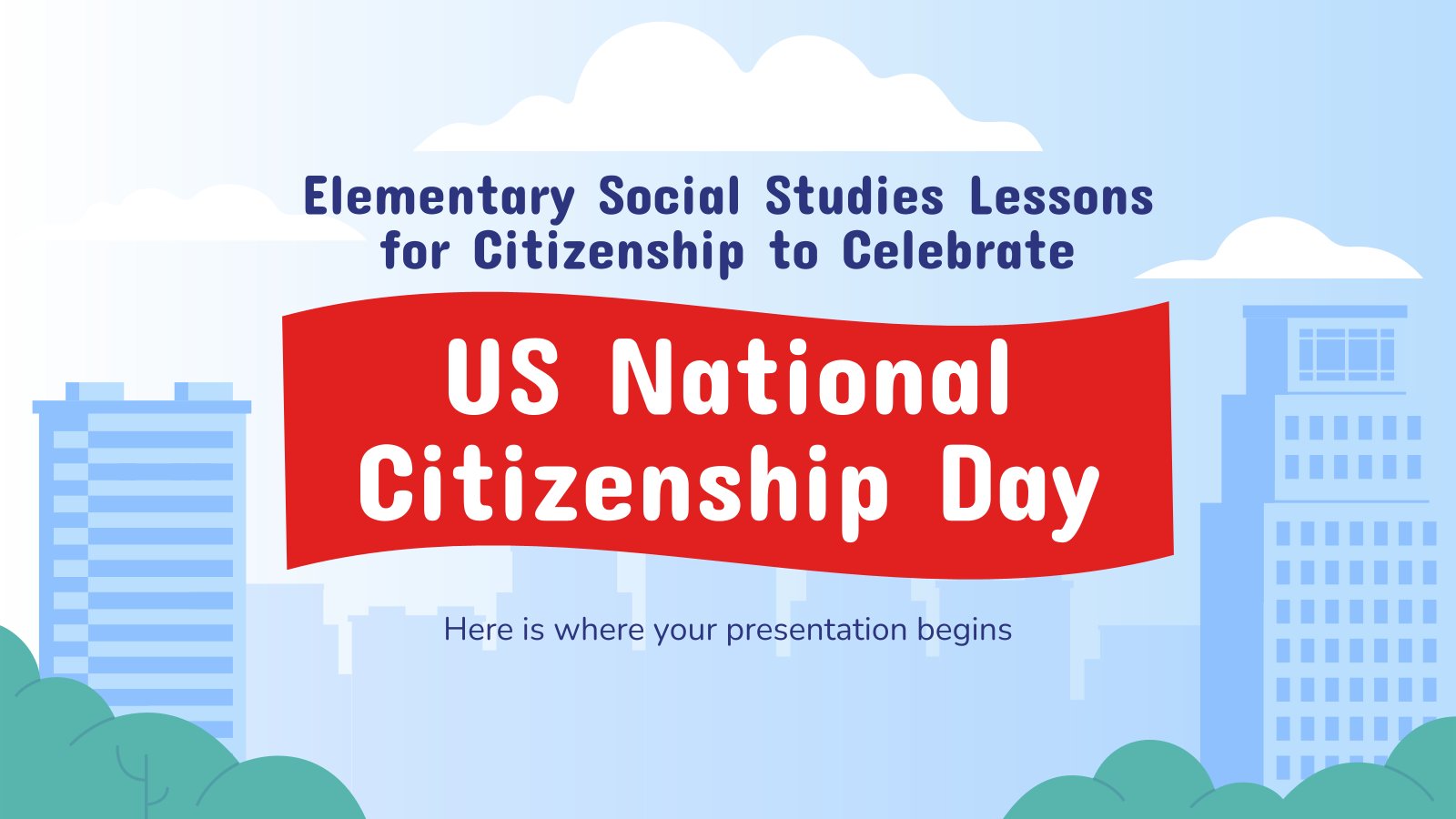
citizenship
14 templates
Creative Presentation templates
Use these free creative google slides themes and ppt templates to give a new twist to conventional slide designs while following the latest trends. your presentation will definetely impress your audience, related collections.

1407 templates

Literature Lesson for National Poetry Month
Download the Literature Lesson for National Poetry Month presentation for PowerPoint or Google Slides. The education sector constantly demands dynamic and effective ways to present information. This template is created with that very purpose in mind. Offering the best resources, it allows educators or students to efficiently manage their presentations...
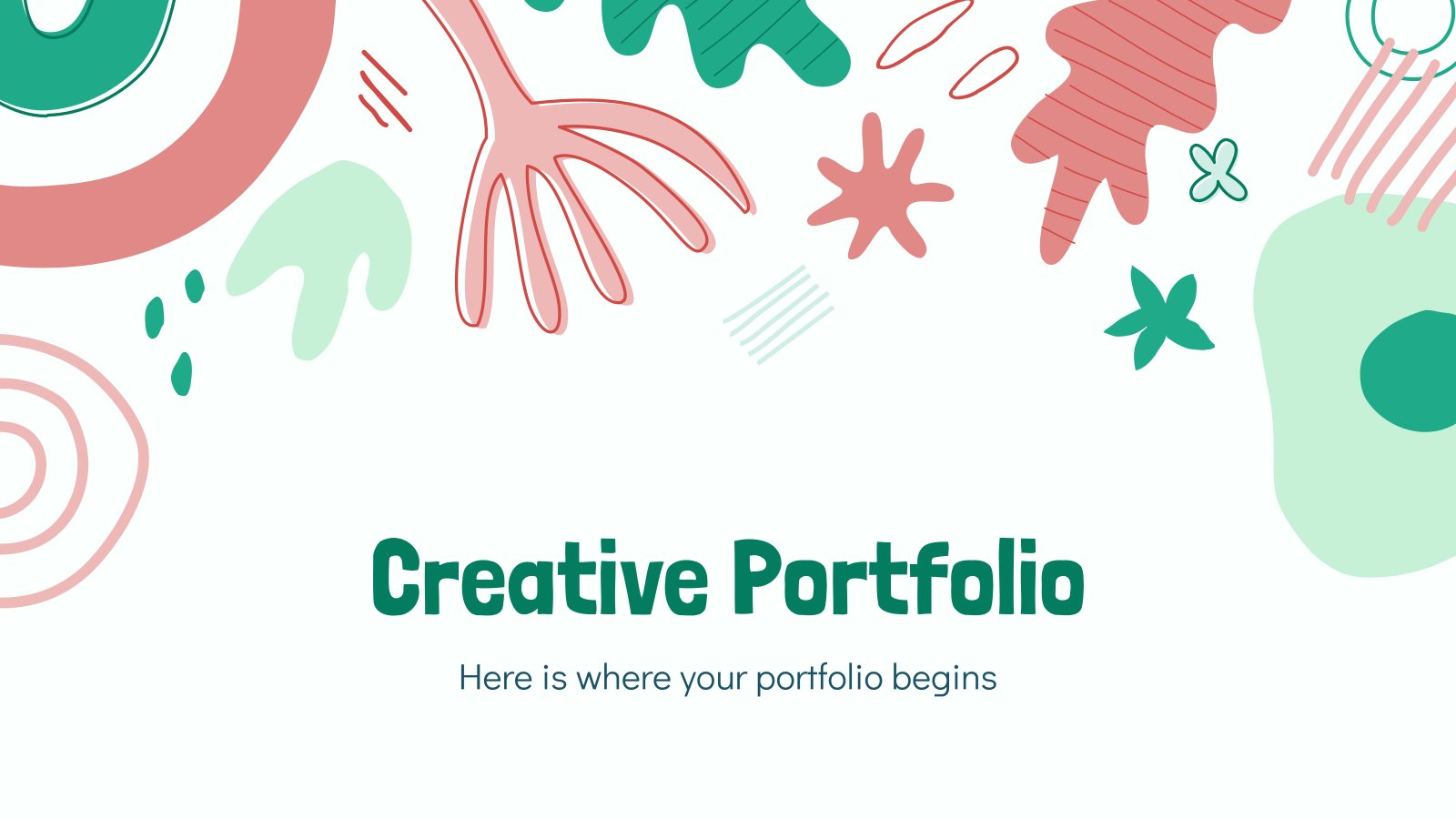
Premium template
Unlock this template and gain unlimited access
Creative Portfolio
Let others know about your potential with this creative portfolio! We have just created a great template to help you share your work with recruiters. Give it a go now!

Rural Cabin Inn Social Media Strategy
Download the Rural Cabin Inn Social Media Strategy presentation for PowerPoint or Google Slides. How do you use social media platforms to achieve your business goals? If you need a thorough and professional tool to plan and keep track of your social media strategy, this fully customizable template is your...
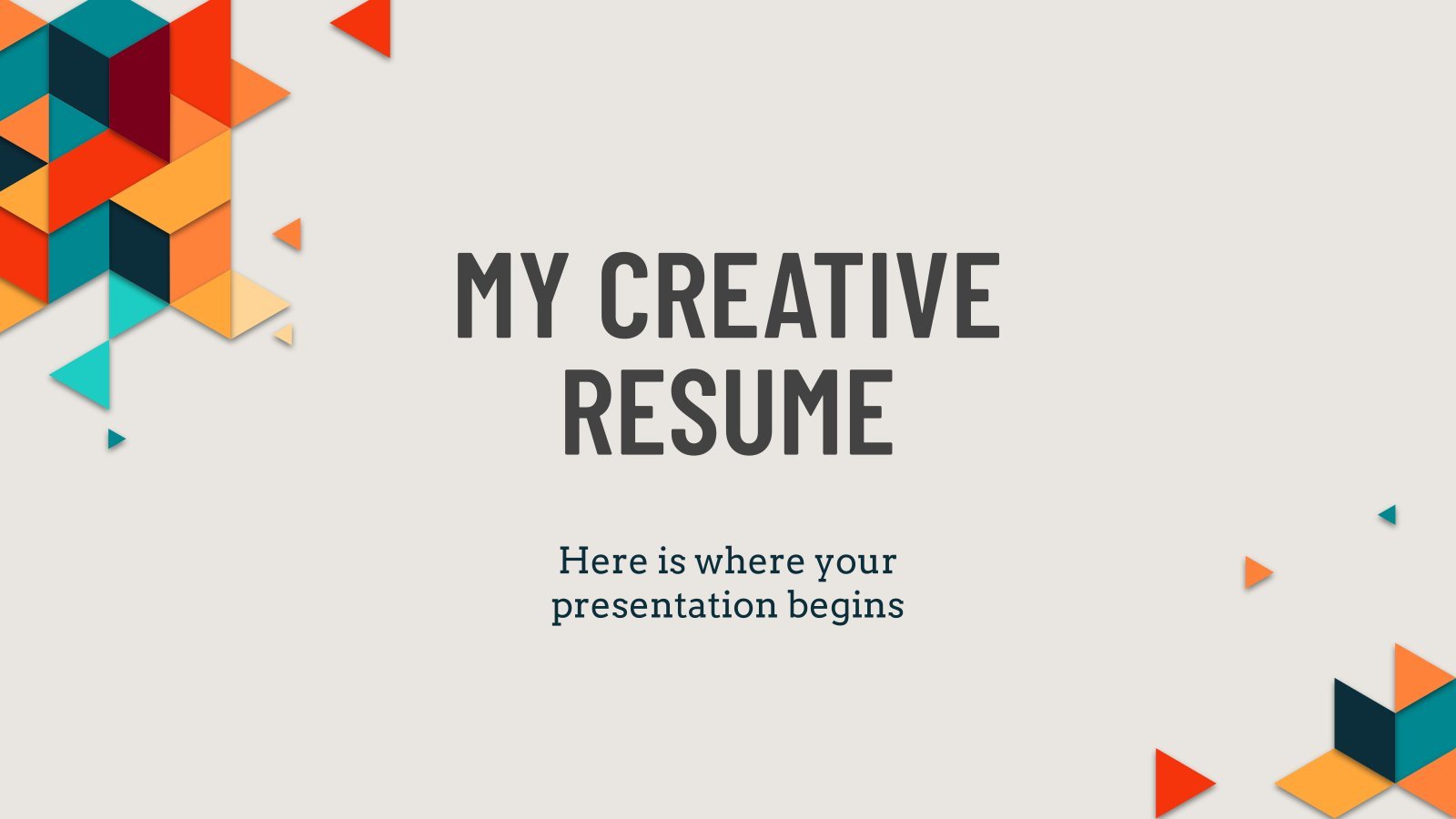
My Creative Resume
A good CV is the key to unlock the doors to the best job interviews. For this reason, here at Slidesgo we go beyond the limits of the conventional design, offering you a modern colorful template whose main focus is no one else but you!

World Wildlife Day
Download the World Wildlife Day presentation for PowerPoint or Google Slides and start impressing your audience with a creative and original design. Slidesgo templates like this one here offer the possibility to convey a concept, idea or topic in a clear, concise and visual way, by using different graphic resources....

Pastel Portfolio
Having a very creative portfolio opens a lot of doors, more than you think. We've created this template for those who want to showcase their work and skills. As always, the Memphis graphic style will help you grab attention, and the pastel colors too! Mention your studies, add images of...
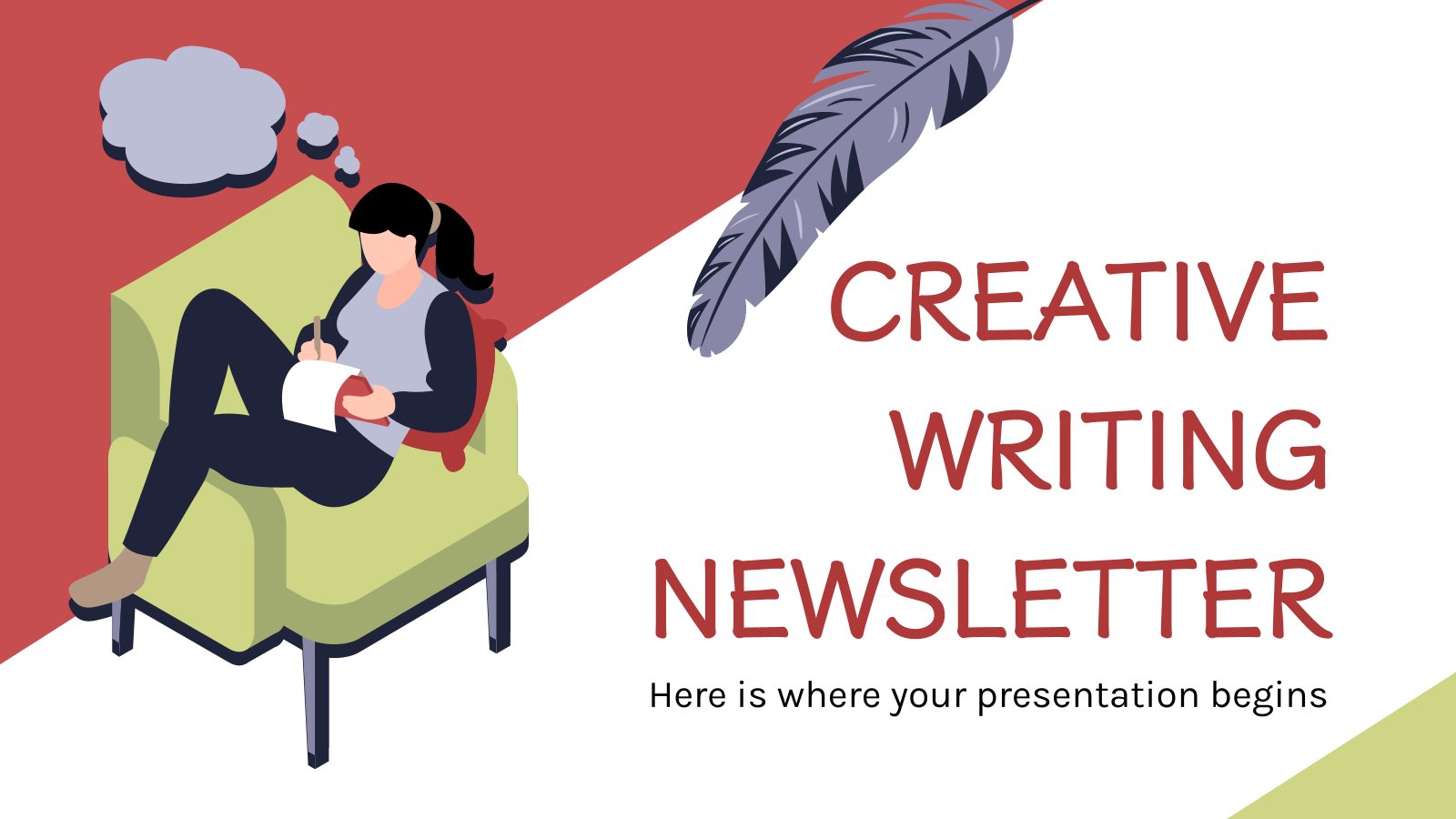
Creative Writing Newsletter
Creative writing is an art form that can be enjoyed by anyone. Whether you're a budding author or a seasoned pro, having a newsletter template to help create content can take off some of the pressure and give you the creative spark you need to write compelling stories. With this...
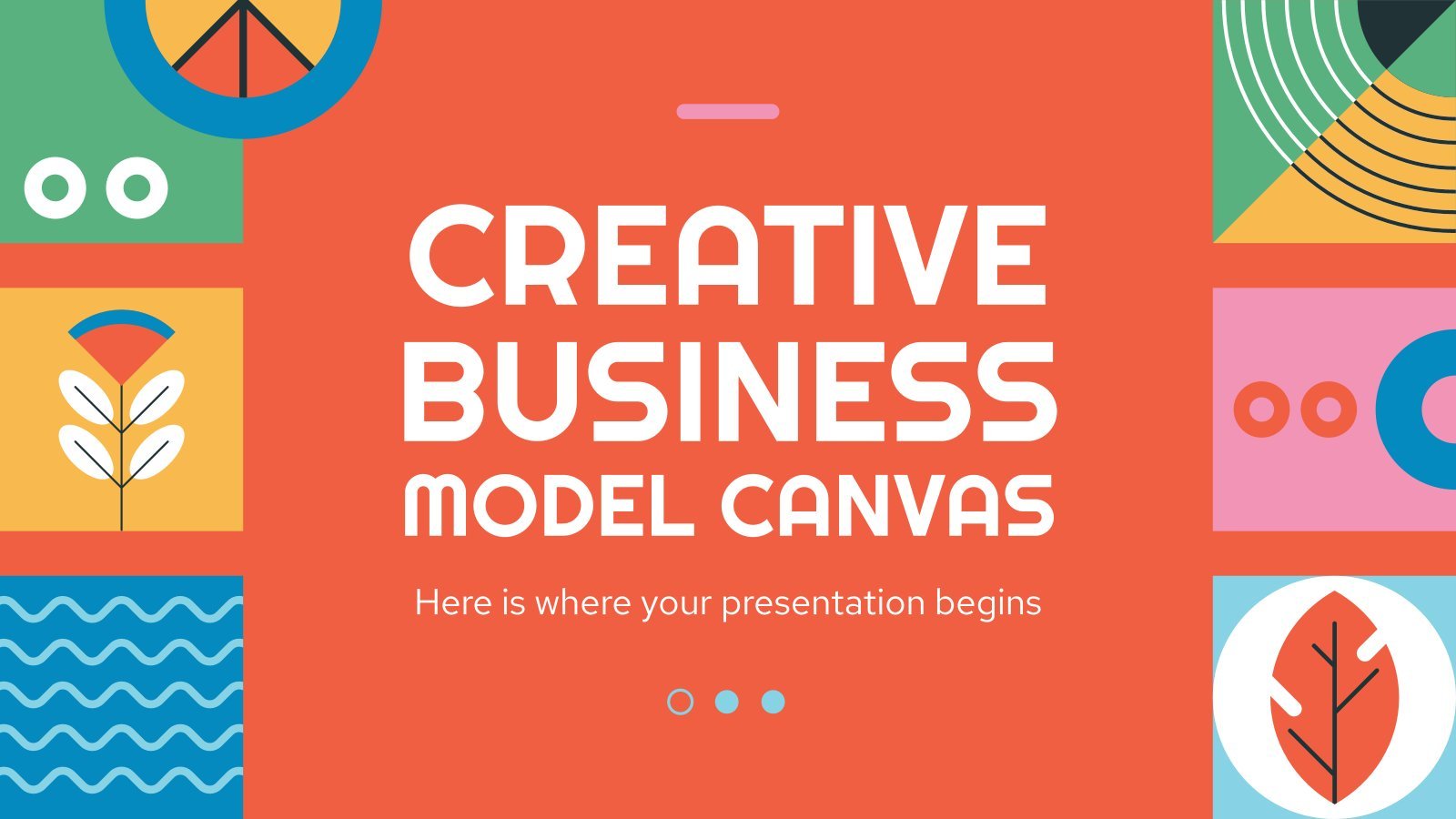
Creative Business Model Canvas
You can introduce your company to other people and talk about your business model. How about having a slideshow that is as colorful, creative and innovative as no other? If that's your wish, we're glad to grant it to you! Download this template and start editing the slides to reflect...

Creative Writing Workshop
We all know how many book lovers there are in the world. Reading is one of the most satisfying activities for many people. How about you encourage your potential students to enroll in a creative writing workshop to help them explore their storytelling skills and expand their literary horizons. Slidesgo...
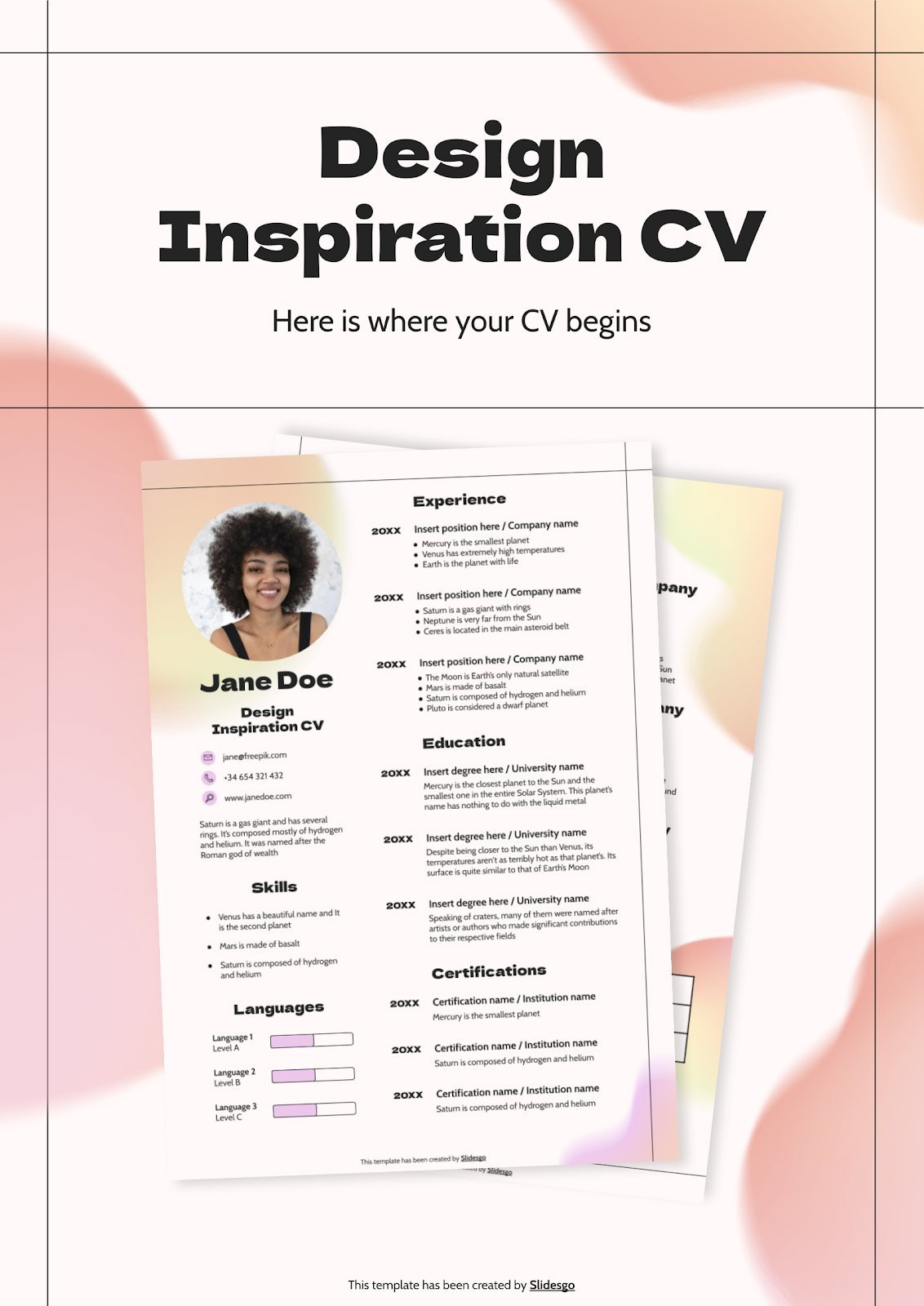
Design Inspiration CV
Download the Design Inspiration CV presentation for PowerPoint or Google Slides. Having a good CV can make all the difference in landing your dream job. It's not just a piece of paper, it's your chance to showcase your skills, experience, and personality. If you want to stand out from the...
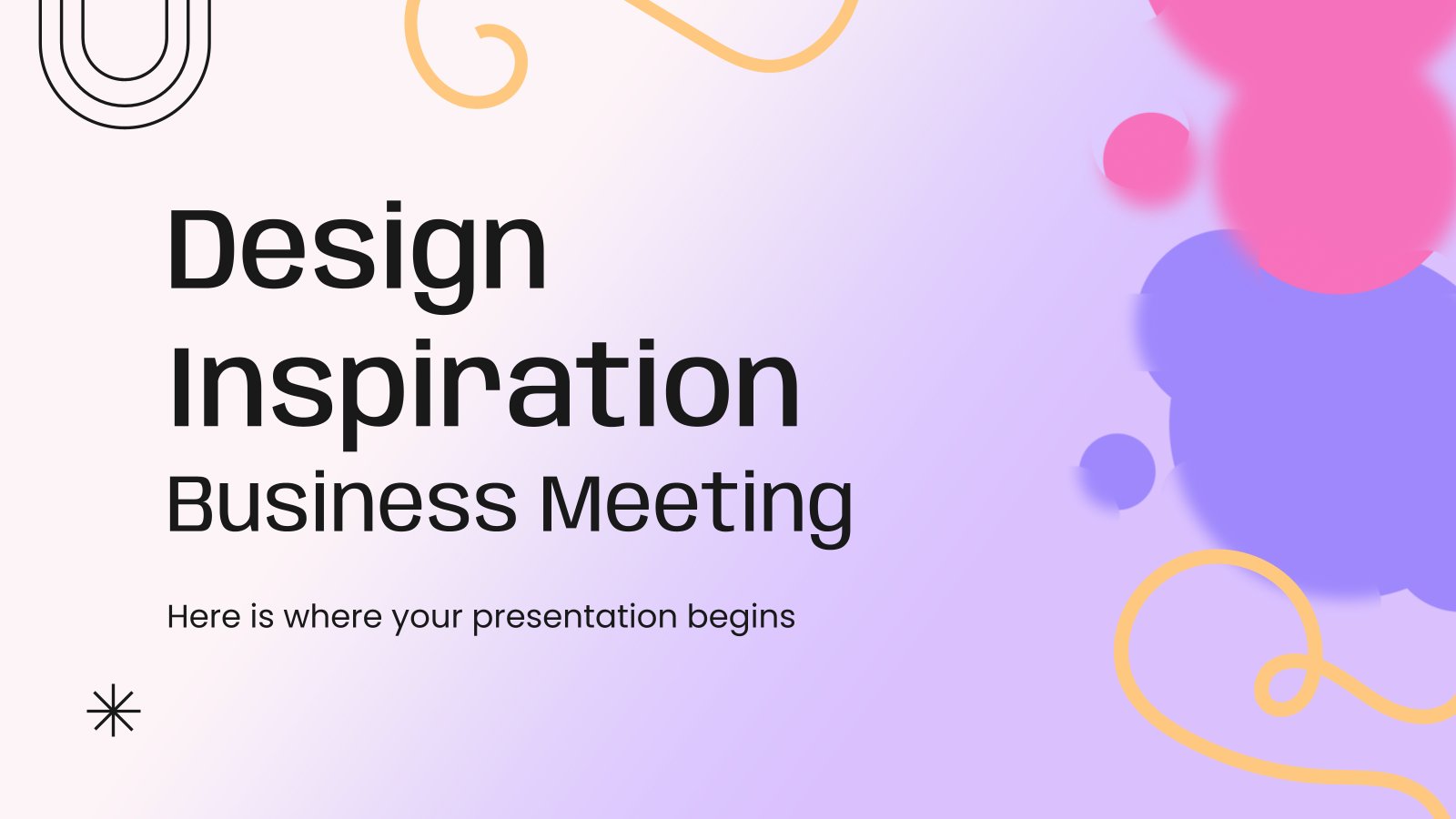
Design Inspiration Business Meeting
Download the Design Inspiration Business Meeting presentation for PowerPoint or Google Slides. Gone are the days of dreary, unproductive meetings. Check out this sophisticated solution that offers you an innovative approach to planning and implementing meetings! Detailed yet simplified, this template ensures everyone is on the same page, contributing to...

Environmental Issues and Sustainability - Spanish - 7th Grade
Download the Environmental Issues and Sustainability - Spanish - 7th Grade presentation for PowerPoint or Google Slides. If you’re looking for a way to motivate and engage students who are undergoing significant physical, social, and emotional development, then you can’t go wrong with an educational template designed for Middle School...

Meet Our Professors
The beginning of the school year is always synonymous with nerves for teachers and students. To break the ice, why not introduce your professors in a different way? We propose you this original template with a dark background and abstract and colorful shapes. It features doodle-style illustrations related to teaching,...

Notebook Lesson
These are the last days before the Summer break! We know that there are some pending lessons that you need to prepare for your students. As they may be thinking about their friends and their holidays, catch their attention with this cool template!

Creative Agency
Do you want to stand out when offering your services? If you’re working for a creative agency, this new template by Slidesgo will be an efficient tool when it comes to attracting new customers.

World Art Day
Download the World Art Day presentation for PowerPoint or Google Slides. The education sector constantly demands dynamic and effective ways to present information. This template is created with that very purpose in mind. Offering the best resources, it allows educators or students to efficiently manage their presentations and engage audiences....
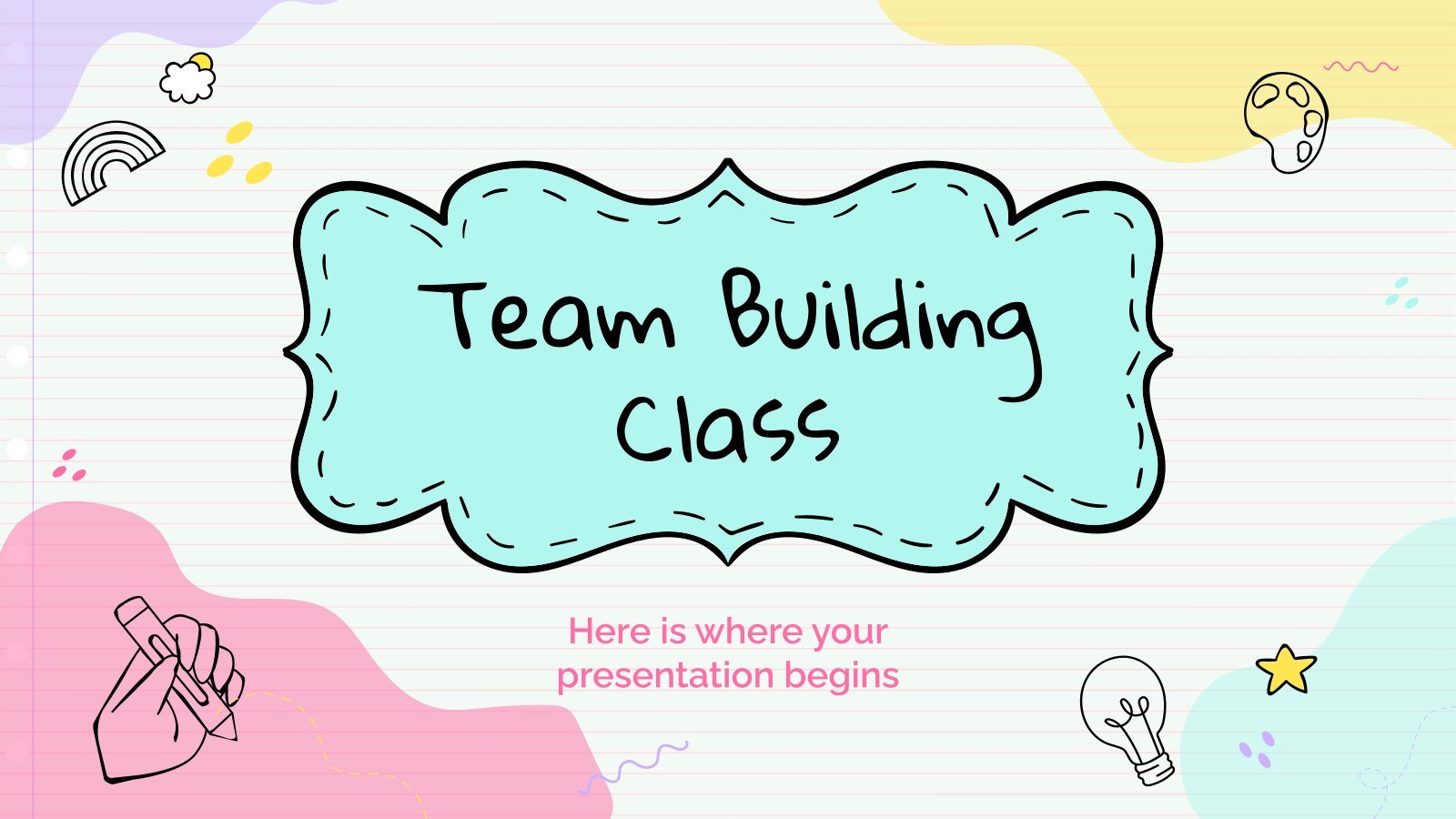
Team Building Class for Elementary
Your students spend most of their days at school, so building a good atmosphere in the class is vital for their happiness. Why don’t you dedicate a day to team building activities? This will help new students make friends and older students create deeper relationships with their classmates. It that...
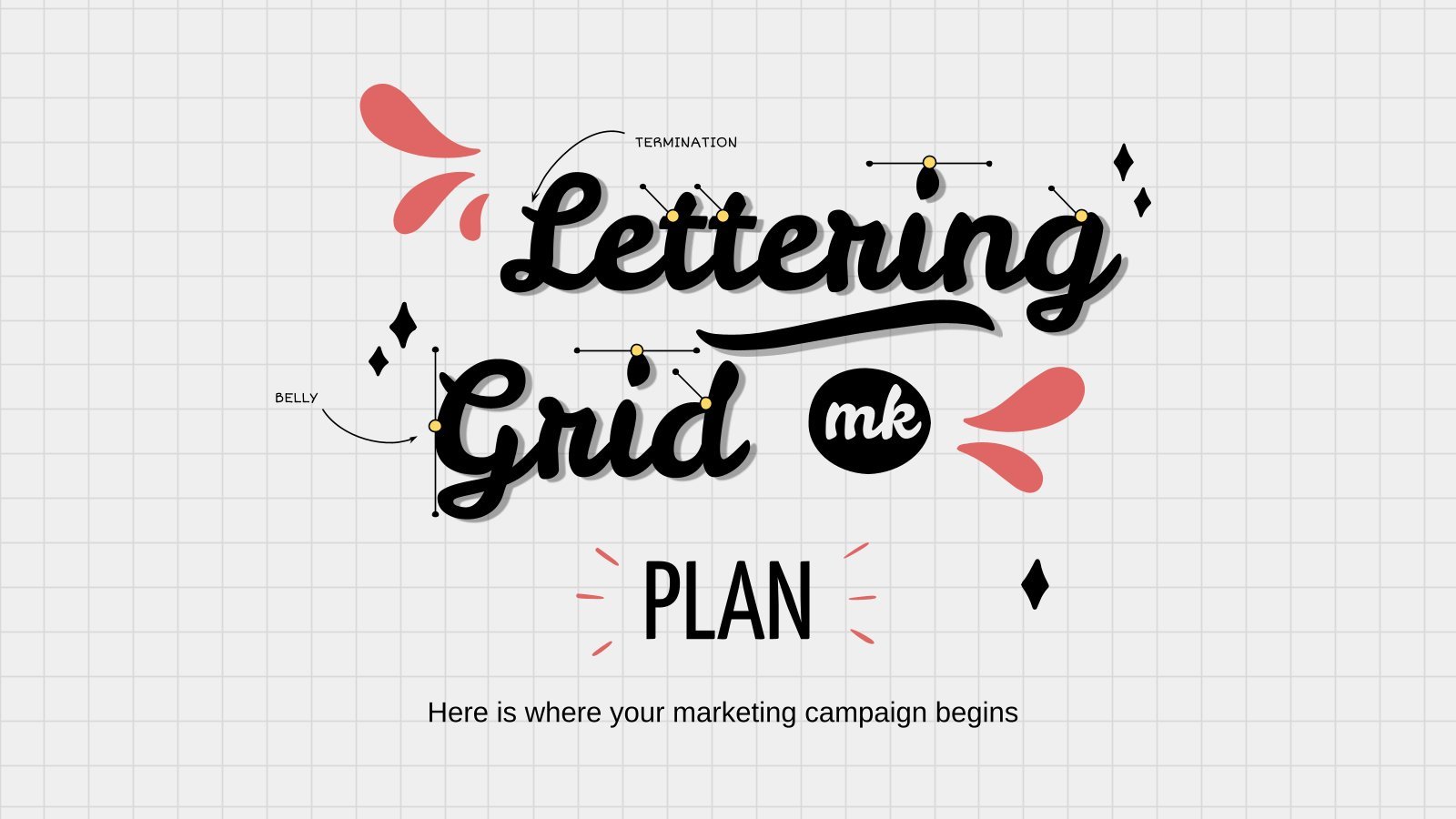
Lettering Grid MK Plan
Do you know what lettering is? It’s the art of turning writing into a masterpiece. Use this beautiful template to explain how to master this beautiful art or to present your marketing plan in an original way. We have included infographics, maps, charts, and lots of letterings to decorate the...
- Page 1 of 284
New! Make quick presentations with AI
Slidesgo AI presentation maker puts the power of design and creativity in your hands, so you can effortlessly craft stunning slideshows in minutes.

Register for free and start editing online

7 Ways to Inspire Creativity in the Workplace and Why it’s Important
Whether it’s creative problem-solving or the flexibility to decide how work gets done, creativity in the workplace is integral to growth, innovation, and the overall employee experience..
In today's rapidly evolving workplace landscape, the significance of creativity cannot be overstated. From fostering innovation to seizing new opportunities, a creative mindset is the cornerstone of success. A creative person, equipped with fresh perspectives and inventive ideas, can transform concepts into reality.
A commitment to cultivating a creative environment empowers teams to brainstorm smart solutions and adapt to challenges seamlessly. Below, we have collated some innovative solutions to make embracing creativity easier than ever, whilst also highlighting why entrepreneurs should prioritize creative thinkers and creative activities within their corporate culture to drive success.
Why is Creativity Important in the Workplace?
The benefits of creativity in the workplace are impressive and far-reaching. Beyond promoting fresh thinking, opening up a space for creativity at work creates a positive company culture in which team bonding is encouraged, employee productivity booms, and out-of-the-box thinking is encouraged.
Here are key advantages of creativity in the workplace:
- Professional Growth: Creativity in the workplace promotes an environment conducive to continuous learning and development. Employees are encouraged to engage in divergent thinking, exploring various perspectives and solutions. This fosters personal and professional growth as they tackle challenges creatively, opening up additional opportunities for employees.
- Innovation and Opportunities: Creative ideas catalyze innovation, driving businesses forward in competitive markets. By encouraging employees to think outside the box, companies can uncover innovative solutions to complex problems, opening new avenues for growth and expansion.
- Positive Outcomes and Solutions: Embracing creativity cultivates a culture where failures are viewed as stepping stones to success rather than setbacks. Employees are more inclined to take calculated risks and experiment with new ideas, leading to freedom of discovery.
- Inclusive Environment: A culture of creativity fosters inclusivity by valuing diverse perspectives and contributions. Employees feel empowered to express their ideas freely, knowing that their voices are heard and respected. This creates a sense of belonging and encourages collaboration among team members.
- Enhanced Everyday Work Life: Creativity injects excitement and inspiration into everyday work life, making tasks more engaging and fulfilling. Employees are motivated to explore fresh ideas and approaches, leading to a more dynamic and enjoyable work environment.
The Best People Management Platform
7 Tips To Inspire Creativity In The Workplace
If you want to provide employees with the freedom to experiment with innovative ideas without the fear of failure, it is essential to foster creative workplaces. However, creativity in business rarely takes center stage, so most business owners don’t know where to start in their commitment to creativity. To make the process easier, we have collated some inventive solutions to help you spark creativity in the workplace.
1. Encourage Creativity With an Inclusive and Fun Team Environment
A genuine team-based environment , in which leaders encourage connections through collaboration and social time, is essential for innovative teamwork. Managers will notice a remarkable difference when the effort is made to “de-silo” the organization. Instead of staying separate and heads-down on only their projects, employees should have the opportunity to interact with colleagues in different departments to gain an informed understanding of the company as a whole. This will spark creative thinking and allow for ideas and inspiration to flow freely across departments.
Additionally, humour in the workplace plays a significant role in team-bonding. Research shows that humour can reduce stress, increase relationship building, and create better cohesion. You can create a "water cooler" channel on Slack or similar chat software to allow your employees to enjoy some office banter, especially if your team is remote or hybrid. You can also add buffer time to your team meetings to allow time for everyone to chat about their weekend plans or other casual conversations.
Of course, humour should be universal and non-exclusionary. Avoid any hot-button topics or things that run the risk of being mean-spirited such as pranks or teasing. It’s also important to note that sarcasm—while common—can “have a corrosive effect” and even come across as degrading when it’s at someone’s expense. A playful but polite company culture helps create a sense of belonging and safety, which is the gateway to creative expression and thought-generation.
2. Promote Creativity Through Office Design
A creative company prioritizes an exciting workspace that inspires creativity and innovation. Even if your office layout is more cubicles than open space, there are still ways that you can help employees feel inspired by their surroundings. For example, you can encourage employees to bring in photos, prints, or small decorative objects from home. You can also hang some artwork on the wall and bring in task lighting and tall lamps.
Add office plants to help purify the air and bring a touch of nature inside. These simple steps bring an inherent element of creativity into any space. You should also consider investing in sit-stand desks to give your employees flexibility and better health, as backaches aren’t conducive to creative thinking. These elements, along with others, can create an atmosphere in which employees feel more comfortable and creative.
3. Provide Freedom and Flexibility in How Work is Done
Creativity in the workplace does not have to mean creativity in the workspace. Sometimes a change of scenery can help spark new ideas. Every now and then, switch up your team routine with off-site and walking meetings. Brainstorming at a coffee shop might generate more ideas than you think, as it helps to break up the routine. You should also encourage any remote or hybrid employees to do the same.
If your employees have returned to the office full-time, consider expanding or updating your current remote work policy to allow employees more flexibility while helping them cut costs and save employees time when it comes to commuting. Offering flexibility in the workplace is essential for not just creativity, but also retention and recruitment , “with 80% of employees identifying it as a crucial factor in job evaluation".
Breaking Routine and Addressing Working-From-Home Fatigue
4. Offer the Space for Knowledge Sharing
There is no shortage of talent and skills within your organization that are just waiting to be passed on. Encouraging your employees to share what they know and what they can do with other coworkers fosters a culture of collaboration which helps spark creativity and allows teams to overcome challenges through creative solutions. This can be done through lunch-and-learns or special classes taught over video or in small groups. Sessions can include Excel tips, LinkedIn profile best practices, and guided meditation/yoga.
Sessions are a great way for your team members to discover new interests or passions that they can master and apply in their roles or to help maintain their work-life balance. By providing a platform for your people to engage in knowledge exchanges, they’ll benefit from professional development in the forms of thought leadership, increased confidence, and increased creativity.
How to Build a Positive Remote Company Culture and Why it Matters
5. Encourage the Practice of Self-Reflection
Encourage employees to get in the habit of self-reflection check-ins. This exercise helps them to focus on what they’ve achieved, as well as what’s coming up next and helps inspire them to see things differently. Rise’s performance management feature includes weekly check-ins . Employees are prompted to rate their week, what went well, and what could’ve gone better.
It’s a great way for managers to keep track of how an employee is doing, while also giving the employee a chance to reflect on their work. If possible, also share monthly or quarterly accomplishments with your team so they can see the concrete results of their contributions.
6. Support Employees in Creative Risk-Taking
Cultivate an office culture that rewards creative risk-taking . One reason why employees are not thinking out of the box or proposing different solutions could be due to a fear of making mistakes and not having their ideas supported. As much as possible, make it clear to your employees that your organization values creativity—and understands its importance.
This can be communicated by being receptive to new ideas and recognizing risk-takers for the impact they've made. As well, be open to feedback and suggestions from your employees. Provide an open door policy or offer an anonymous outlet for anyone who wishes to share their thoughts privately.
How to Create an Effective Open Door Policy at Work
7. Encourage Healthy Competition
Healthy competition in the workplace can be encouraged through various means, fostering innovation and creativity. Business owners can initiate challenges that stimulate employees' innovation skills and encourage the flow of ideas. By promoting a culture that embraces risk-taking and learning from failure, employees feel empowered to explore innovative solutions to challenges. Through fostering a competitive edge, teams strive to outperform each other, driving them to push boundaries and generate novel ideas.
Discover How to Encourage a Healthy and Creative Working Environment
Rise 's people management platform fosters a positive working environment by prioritizing employee engagement and satisfaction. With features like seamless onboarding, performance tracking, and feedback mechanisms, it promotes transparency and communication.
By streamlining HR processes and empowering employees, Rise cultivates a culture of trust, collaboration, and growth. This creates a supportive atmosphere where individuals thrive, leading to a happier and more productive workforce.
Bring life to work, and your inbox.

A comprehensive list of common (and petty) workplace pet peeves

Pride month and performative allyship in the workplace

Why sustainability in the workplace should be a part of company culture
Give your employees, and yourself, the experience we all deserve..

IMAGES
VIDEO
COMMENTS
A great way to kick off the introduction to your creative self-introduction PPT is to tie yourself to the topic and then tie the topic to the audience. Start by stating your name and job title and then share a random or a fun fact about you. Then, transition into the main part of your presentation about yourself. 4.
Download it for free now! 8. Creative Business PowerPoint Template. If you prefer a one-page self-introduction, take a look at this template. It contains icons, timelines, statistical graphs, and more resources. Like the previous designs, the download is completely free! 9. Creative Pitchbook PowerPoint Template.
Self Introduction PowerPoint Template by SlideModel. 1. Create a List of "Facts About Me". The easiest way to answer the "tell me about yourself" question is by having an array of facts you can easily fetch from your brain. When it comes to a full-length about me presentation, it's best to have a longer list ready.
Ask a trusted friend or mentor to share what you can improve. Asking for feedback about specific experiences, like a recent project or presentation, will make their suggestions more relevant and easier to implement. 2. Study people who have been successful in your role. Look at how they interact with other people.
Me, Myself and I. Download the Me, Myself and I presentation for PowerPoint or Google Slides and start impressing your audience with a creative and original design. Slidesgo templates like this one here offer the possibility to convey a concept, idea or topic in a clear, concise and visual way, by using different graphic... Multi-purpose.
3. Use a Problem, Solution, Benefit Format. Set up your presentation, by concisely speaking to your main point —the problem you will be addressing. Then, allude to the solution (s) you will provide as well as the benefits and outcomes that your audience will receive from implementing your solution (s). Brevity is your friend when you ...
An important step in creating an introduction presentation is choosing a creative self-introduction PPT template. Templates save time instead of making a presentation from scratch. This tutorial looks at the premium Grey PowerPoint template from Envato Elements. This template comes with over 50 slides.
Step #2: Tell your audience what problem you can solve for them. This is where all of the pre-work comes into play. In this step, you will use the answers to one of those questions that you answered earlier. For instance, if my topic is how to deliver presentations, I have to determine why the audience would care.
3. Create a short segment to engage the audience first. Before you begin talking about yourself in your presentation, you can first engage the audience with a short segment. There are several effective approaches you can try to recognize your audience and draw their attention. Some presenters may introduce a compelling quote or statistic and ...
Also, this part sets the tone for your entire presentation. Hence it should be compelling enough to woo your listeners. Creative Ways to Introduce Yourself to the Audience 1. Start with Your Name and Background Information. Though this is an age-old way of self-introduction, it's always in trend and most preferred by global presenters.
The secret structure of great talks. From the "I have a dream" speech to Steve Jobs' iPhone launch, many great talks have a common structure that helps their message resonate with listeners. In this talk, presentation expert Nancy Duarte shares practical lessons on how to make a powerful call-to-action. 18:00.
See more presentation about yourself: https://youtu.be/XQjuPBnrE_YThis video will show you how to make a PowerPoint presentation about yourself, myself. You ...
Free Google Slides theme, PowerPoint template, and Canva presentation template. You never know when a slideshow about yourself could come in handy. Be prepared and use this template to introduce yourself to the audience. Explain your work, your strengths, your personal goals, your values, whatever you can come up with!
In this video, you will learn how to make presentation introduce yourself, myself in the most creative ways. Very easy to make, just use some basic shapes, P...
21 Get crafty (ripped paper details) Sometimes to tell a story, visual details can really help get a mood across. Ripped paper shapes and edges can give a presentation a special feel, almost as if it was done by hand. This visual technique works for any type of presentation except maybe in a corporate setting.
These presentation templates are suitable for self-introduction purposes. They can be used by individuals who want to introduce themselves in a professional or personal setting, such as job interviews, networking events, or personal presentations. Download these self-introduction templates to make a memorable first impression with your audience.
Template 4: Self Introduction Model PowerPoint Presentation Slide. With the help of a PowerPoint Presentation, you create a profile for yourself in which you state your qualifications, work experience, skills, education, hobbies, and much more. If you want to show your aptitude for the job, download this PPT Theme now.
Hence, the way you dress can actually become a topic of conversation and help others remember you. 7. Make a T-shirt. On the front: "On the back of this shirt is everything you need to know about me.". The rest is self-explanatory. 8. Make a "business" card. Keep something with you to give away to new people you meet.
Presentation idea #1: Play with shapes and graphics. An eye-catching presentation instantly makes the audience sit up and pay attention. This means going beyond just text and photos! Layering elements like graphics and shapes throughout your slides is a great way to add more visual interest. Via Behance.
5. Personal interests: Wrap up your self-introduction by mentioning a few personal interests or hobbies, which can help to humanize you and make you more relatable. For example, "In my free time, I love hiking and exploring new trails. I'm also a big fan of trying out new restaurants and cooking at home.".
Choose a design from our presentation templates or create your own from scratch. Customize your presentation with colors, fonts, and key information. Add animations, videos, images, illustrations. Use assets and other media content from your Brand Kit (Pro) to stay consistent with your business or school brand.
Dol Purnima. Download the Dol Purnima presentation for PowerPoint or Google Slides and start impressing your audience with a creative and original design. Slidesgo templates like this one here offer the possibility to convey a concept, idea or topic in a clear, concise and visual way, by using different graphic resources.
One example could be a presentation covering "The Best Free Alternatives to Microsoft Office.". Memoir: Tell the stories of influential people or your own in a value-packed presentation. Video Games: You can reveal the pros and cons of a game or just talk about the trendiest games as of now.
5. Encourage the Practice of Self-Reflection. Encourage employees to get in the habit of self-reflection check-ins. This exercise helps them to focus on what they've achieved, as well as what's coming up next and helps inspire them to see things differently. Rise's performance management feature includes weekly check-ins. Employees are ...